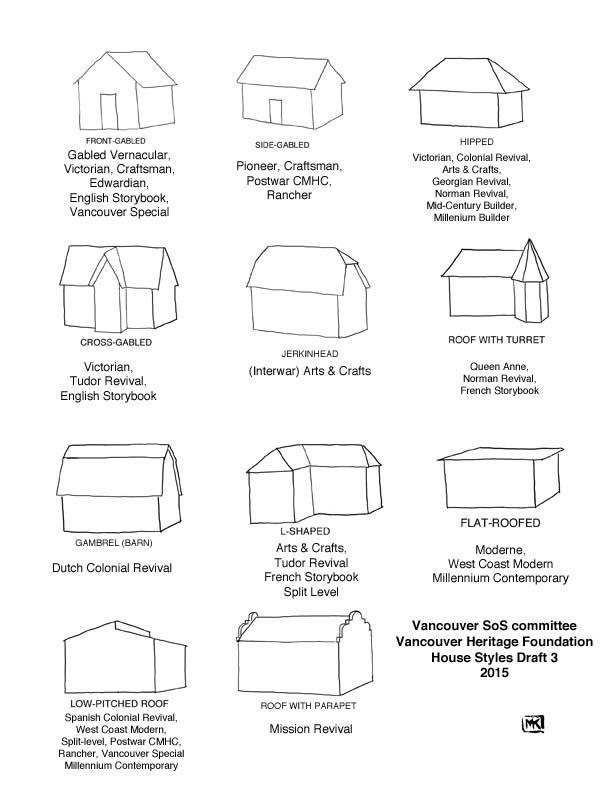
Pioneer (1886 - 1910)
The first houses were simple, side-gabled cottages or cabins, often only one room deep with the door set in the middle (called I-houses in the USA), usually with a full-width hipped-roof front porch. Most were placed near grade on primitive foundations with only a couple of steps up to the front porch. Some are 1-1/2 storey. There was no central heating in them and little need to dig a basement deeper than a small root cellar. They are rare in contemporary Vancouver. An evolution of the Pioneer Style was the Victory House, built quickly during the Second World War in North Vancouver and at Burkeville on Sea Island.
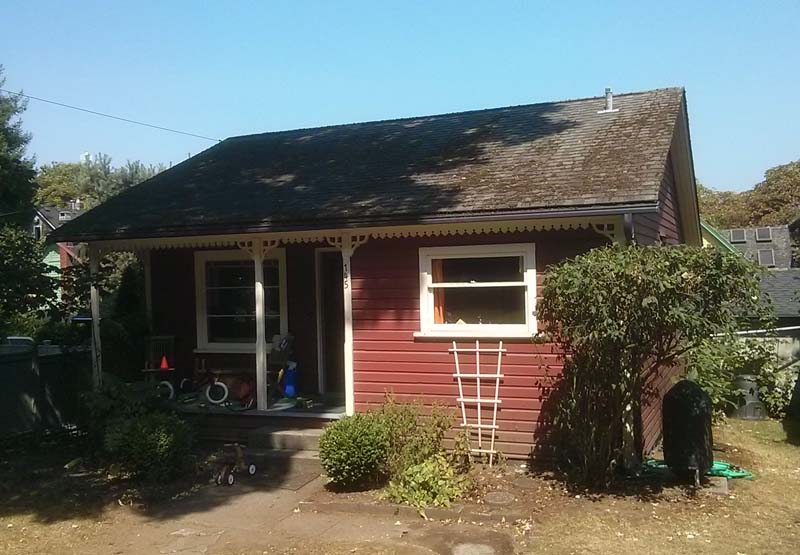
145 West 11th, a modest cottage built around 1900 and connected to the water system in 1904, with drop-siding and an integral half-porch with fretwork detailing. The fire-atlas notation has "S.P." on it: stove pipe, i.e. it was a cabin without a proper chimney.
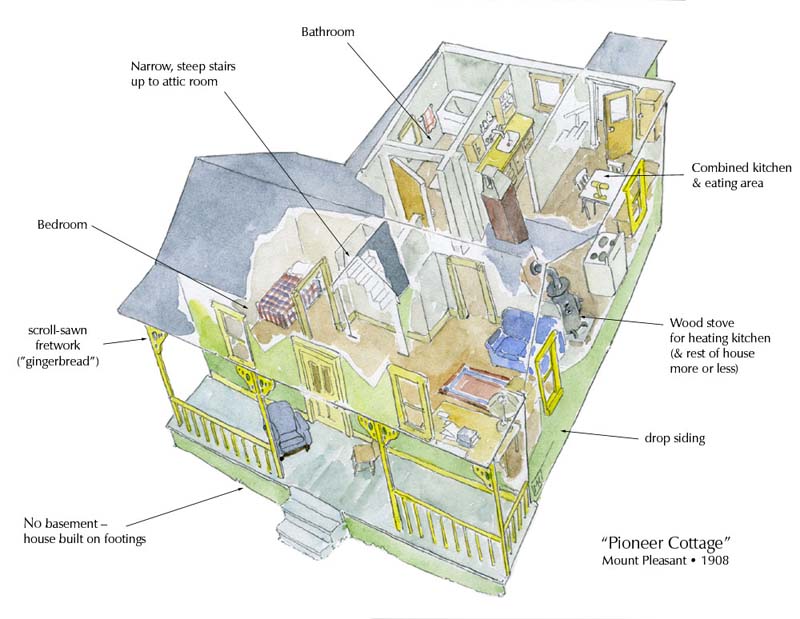
1016 East 7th Avenue, a Pioneer-style cottage built in 1908. The toilet and kitchen block attached to the back under a shed roof was a typical extension to the basic house.
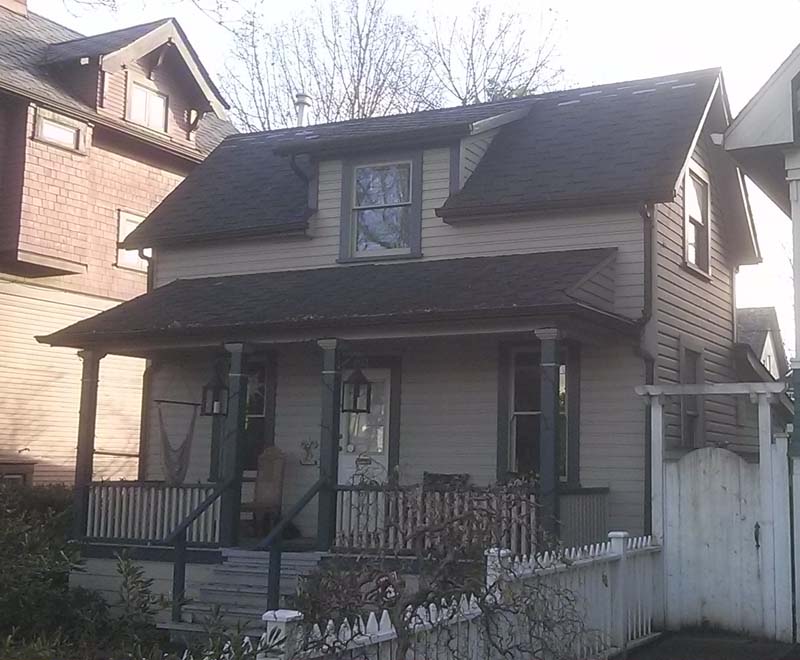
576 West 17th, a classic "I-house," one room deep with an tiny upstairs and a kitchen on the back underneath a shed roof.
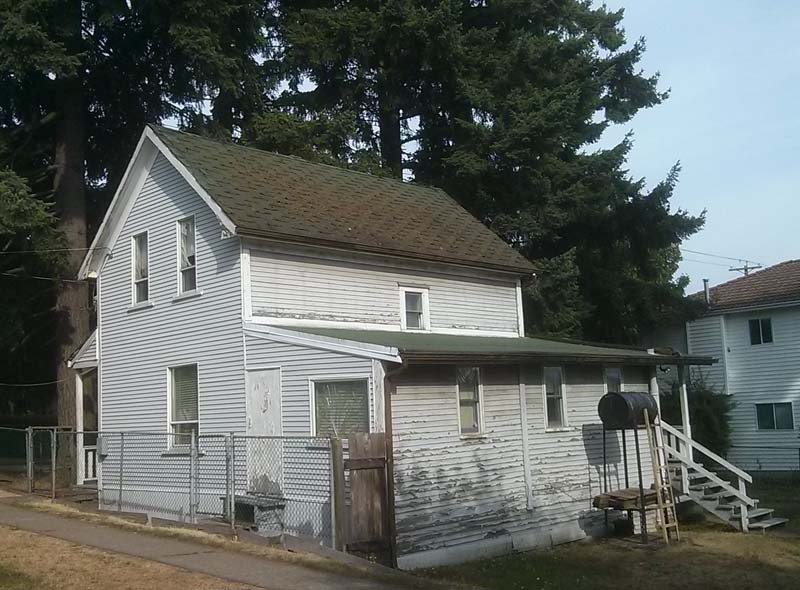
4396 Windsor, seen from the rear; its original cladding is drop-siding, which has been replaced with vinyl siding on the left-hand elevations.
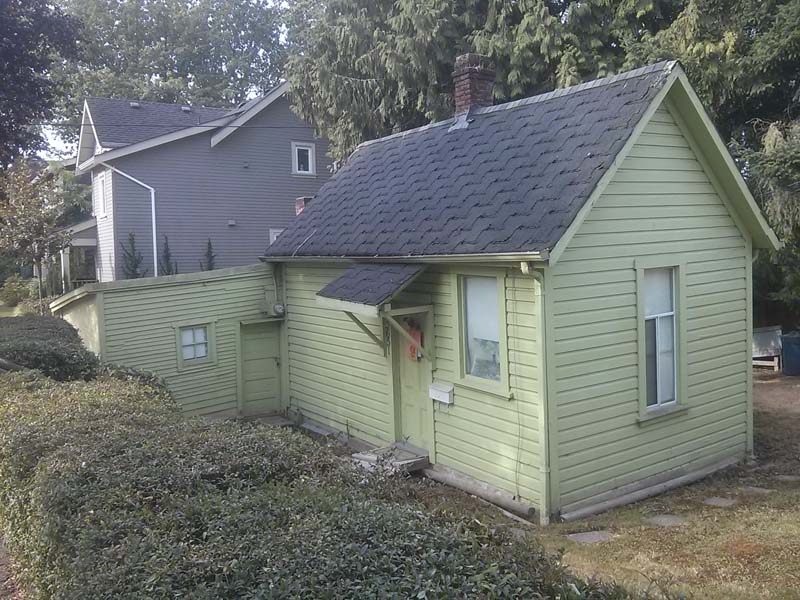
3651 Windsor, a small workman's cottage built post-1912, perhaps for one of the employees at greenhouses nearby; it has side gables, drop-siding and a simple shed roof sheltering the front door.
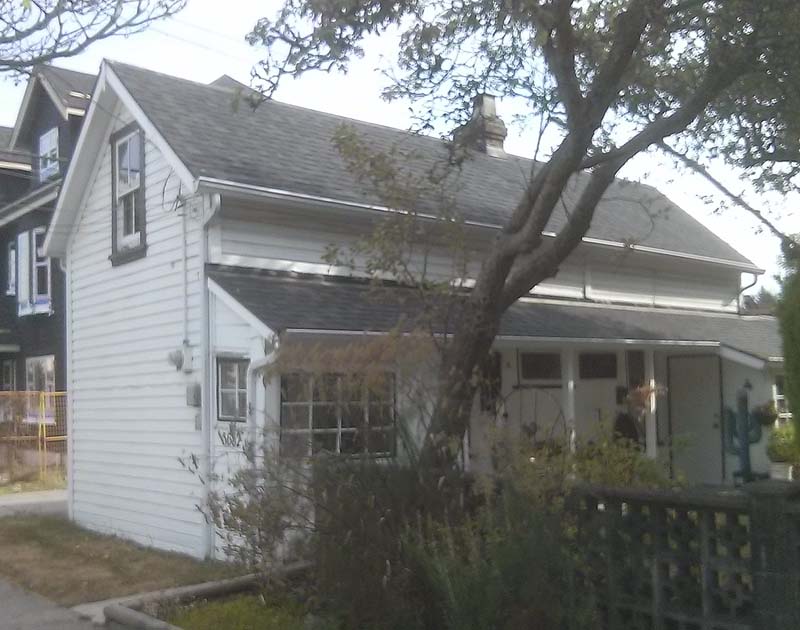
3632 Windsor near Kingsway, a pre-1912 side-gabled building one room deep with an attached, shed-roofed porch, clad in drop-siding.
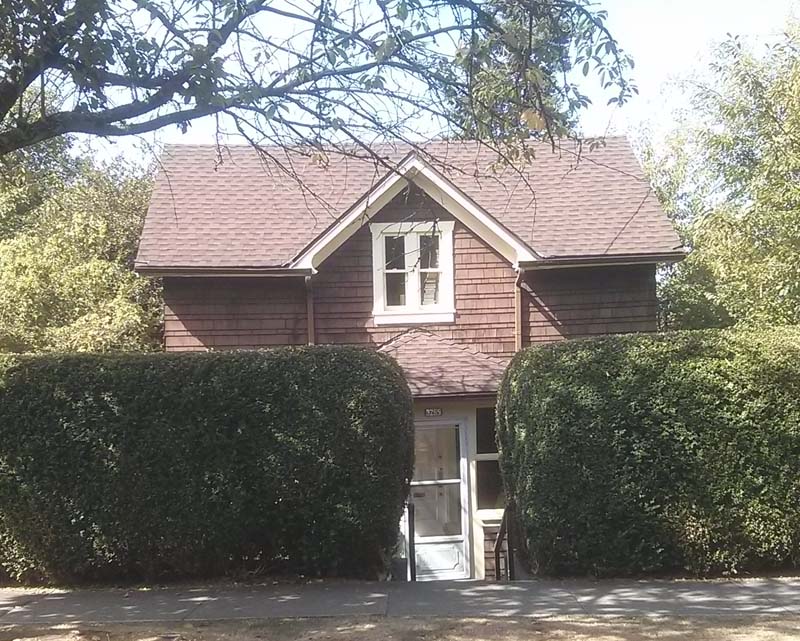
3265 Dumfries has the side gables and modest size of a Pioneer-style house but has a gabled wall dormer like a Victorian cottage, examples of which no longer exist in Vancouver.
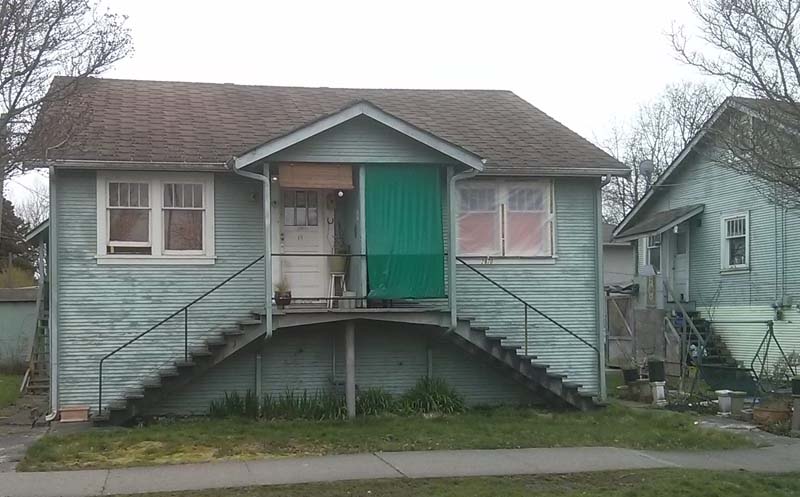
2860 Lakewood, duplex cottages built in 1928 (VanMap) for ??
Gabled Vernacular (1886 - 1915)
The most common surviving houses of old Vancouver, they are 1-1/2 to 2-1/2 storeys tall with front-gabled roofs; the roof may have a skirt across the bottom of the gable. In this style, the house is usually set a half to a full storey above the ground (due to the basement space required for central heating). Its full-width front porch commonly has a hipped roof held up by posts (typically round Tuscan-style). The front door is almost always set on one side of the facade in line with the front stairs and there may be a bay window on one side of the porch, sometimes repeated on the upper storey. Dormers may be hipped or gabled. Examples of the style usually have very few decorative elements such as brackets and fretwork.
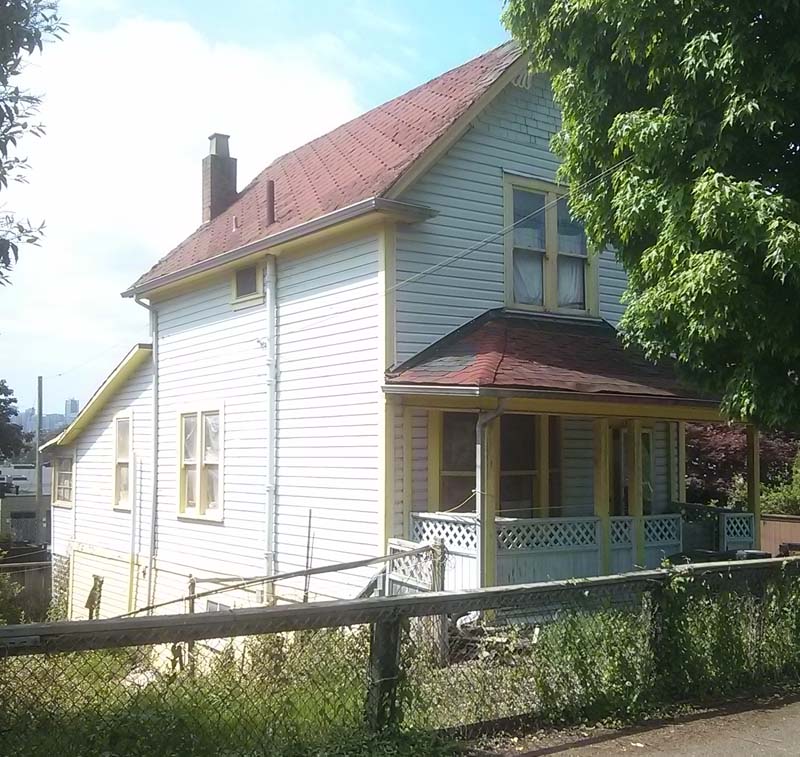
1335 Woodland, clad in drop-siding with a hipped-roof porch. The exterior plumbing stack suggests that indoor plumbing was added after the house was completed.
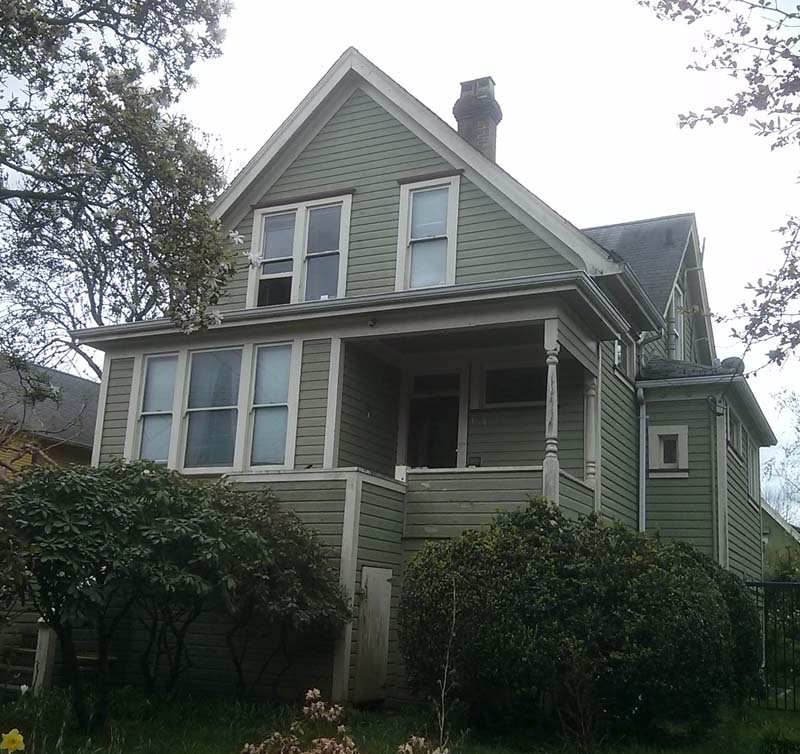
1744 Grant, clad in drop-siding, an example that combines the form of the Gabled Vernacular with the cross-gable sometimes seen in the Victorian Style. The partially enclosed front porch and staircase are probably not original.
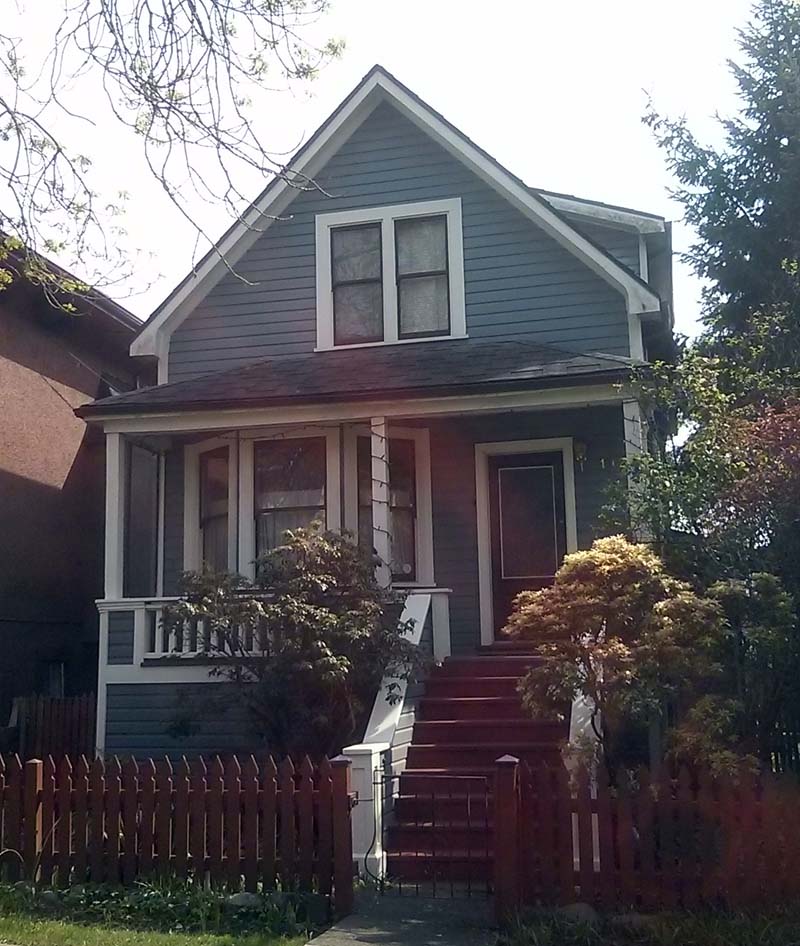
1962 Grant, a simple example with a hipped-roof porch and a bay window on the main floor.
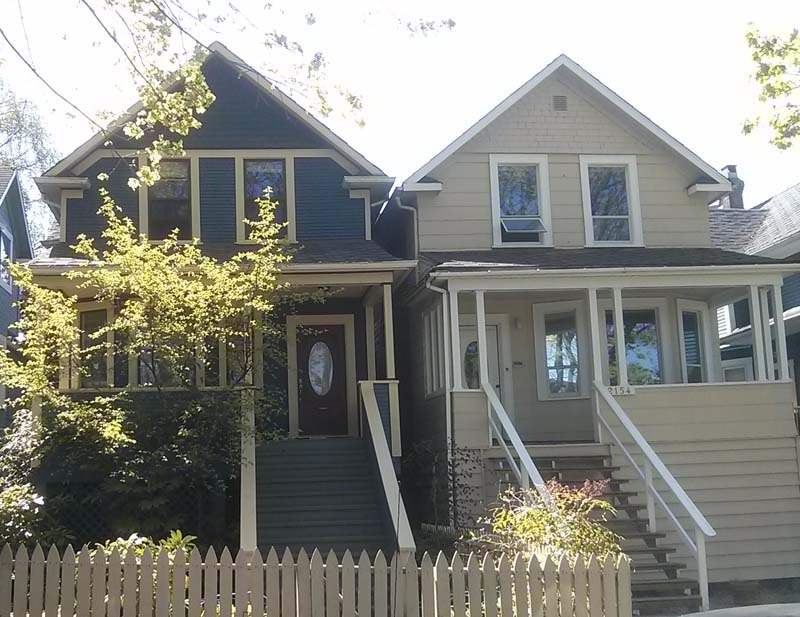
2148 and 2154 West 13th, two houses sharing a 50-foot lot.
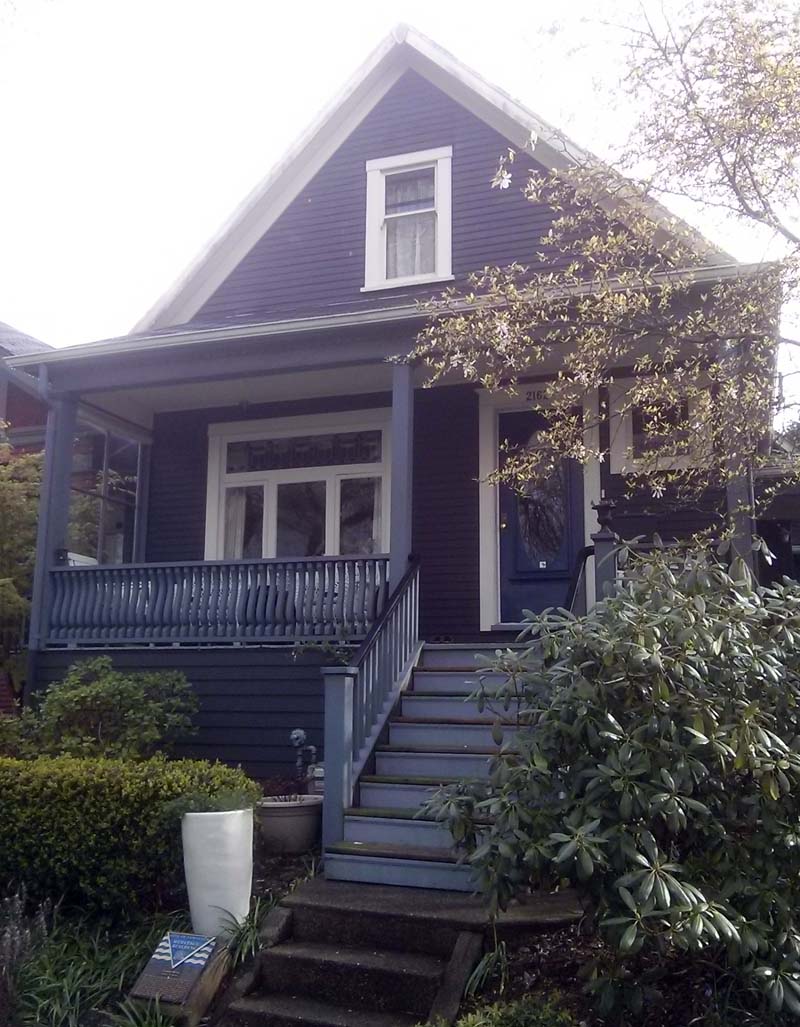
2162 Parker Street, with "pot-belly" spindles (balusters) on the porch railing.
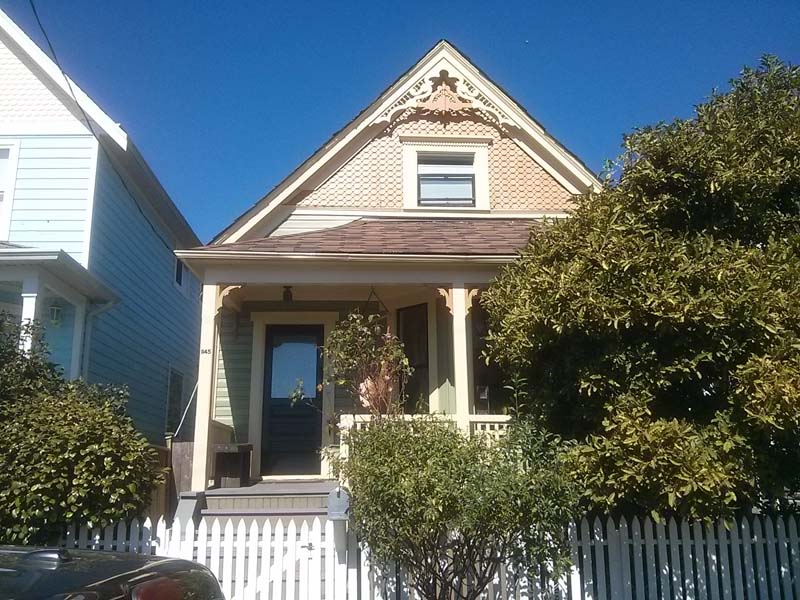
1145 Union, a simple Gabled Vernacular house with elaborate cladding textures and fretwork of the Victorian Style

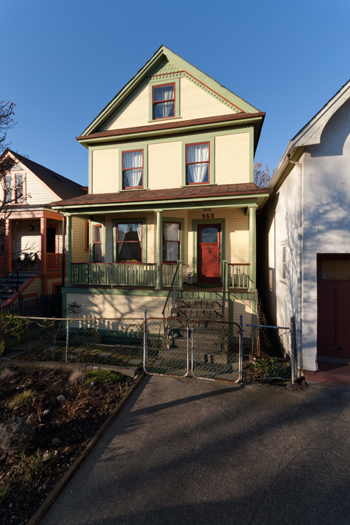 2 unidentified ones from the VHF website with gable skirts
2 unidentified ones from the VHF website with gable skirts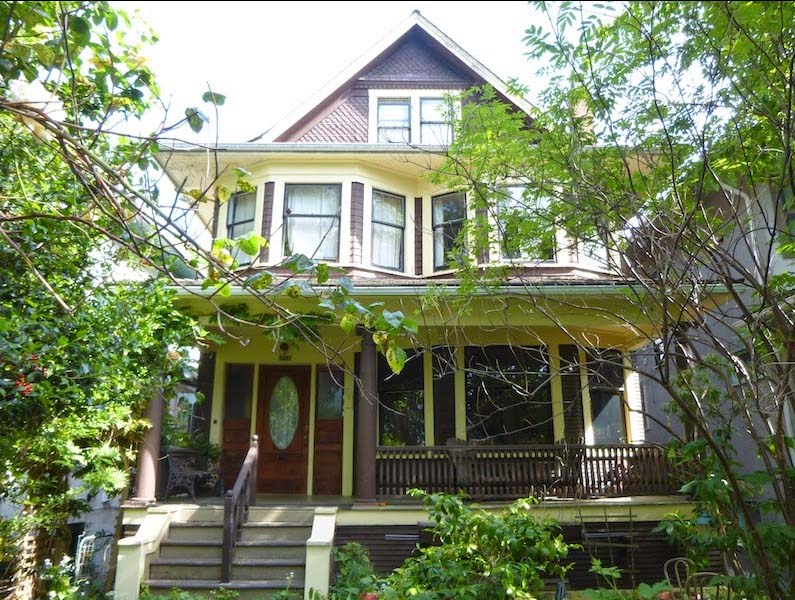
1749 William, an elaborate version of the style with gable skirt, bay windows on both floors and decorative shingling and dentils in the gable.
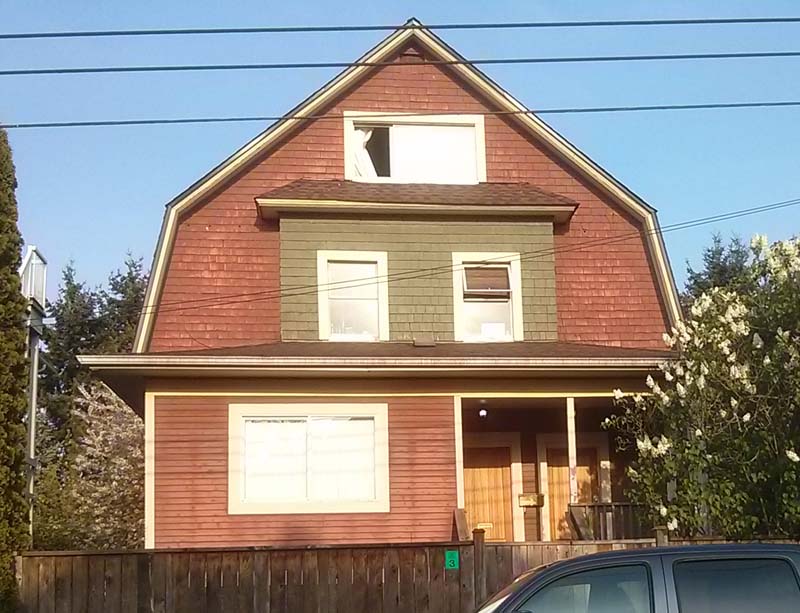
2638 Fraser Street: a rare, much-altered example of the style with an unusual gambrel (barn) roof.
Victorian (1886 - 1905)
Asymmetrical, narrow, 2-storey houses, typically set low to the ground (as they lacked central heating), with a prominent bay on one side which may ascend to the roof, which is typically a gabled one; a half-porch sheltering the front door sometimes supports a small deck space for the upstairs; highly decorated surfaces, especially fish-scale shingles, are typical in gables and on dormers, as are elaborate fretwork brackets on porches, bays, and under eaves. The style is rare in Vancouver outside of Strathcona; earlier examples from the downtown and the West End have mostly been demolished.
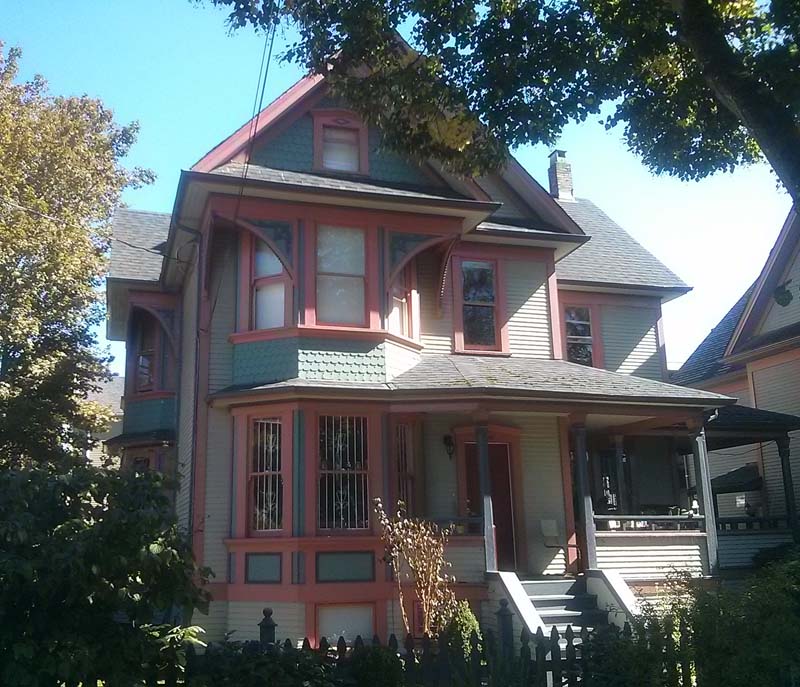
800 Jackson, a cross-gabled example with a very prominent, bracketed two-storey gable on the left-hand elevation and what is probably an addition to the original house on the right-hand side made possible by the wide lot.
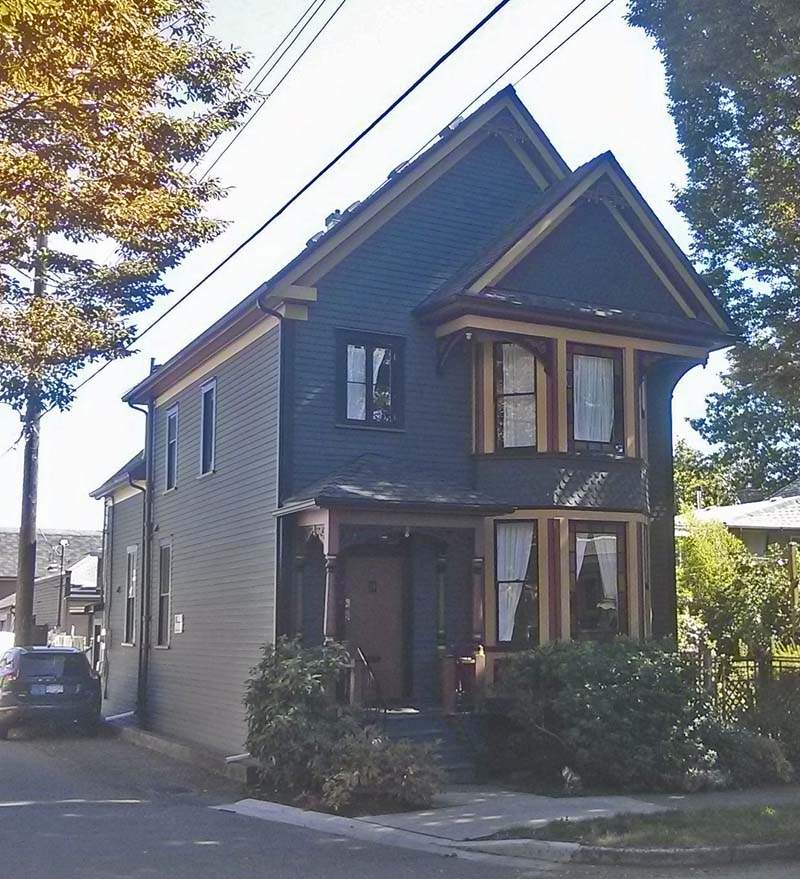
630 Princess, a gabled Victorian with a two-storey gabled bay and a small, hipped-roof porch over the front door. The elaborate brackets and shingle patterns are typical of the style.
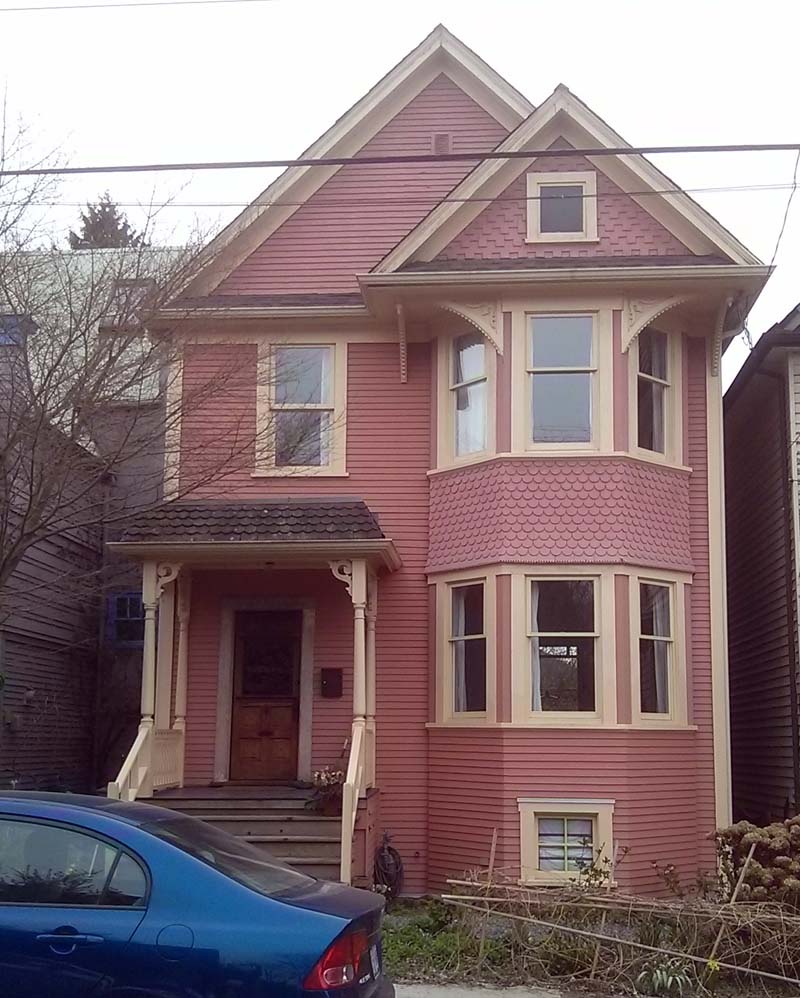
1972 William Street, with decorative shingles on the two-storey bay and in its gable and elaborate fretwork detailing on the bay and the porch posts.
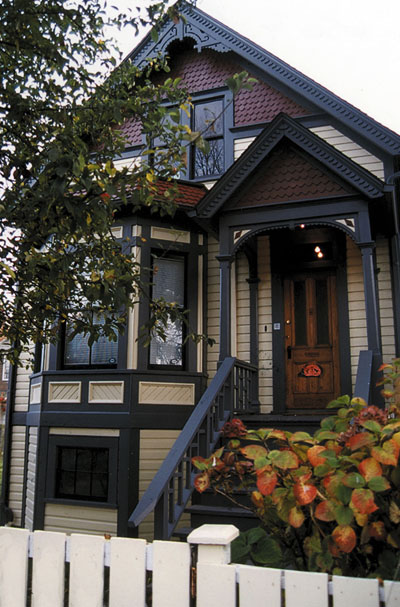
656 East Cordova, a gabled example of the Victorian Style with a single-storey bay, drop-siding, fishscale shingles in the gable and elaborate detailing in the fascia boards.
Colonial Revival (1886 - 1915)
The defining element is the hipped roof, most of which have a single dormer centred on the front.
Cottage form: a single-storey, boxy house with an integral porch, usually with the front door placed in the middle. There may be a bay window on the livingroom side. Some have a bell-cast flare to the eaves. Porch posts are usually round (Tuscan) and may be grouped in twos or threes at the corners. The porch entablature is sometimes decorated with dentils, and the soffits with narrow carved brackets. Usually, the upstairs attic space, illuminated by small windows front and back in the dormers, is too small to be usable due to the low roof pitch. Cladding is typically narrow lap-siding.
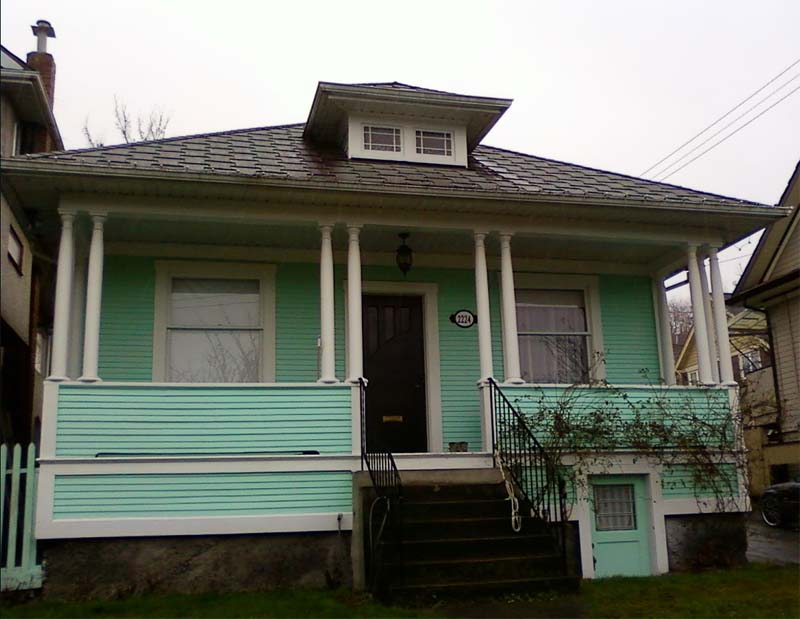
2224 Victoria Drive, with narrow lap-siding and multiple Tuscan columns holding up its roof.
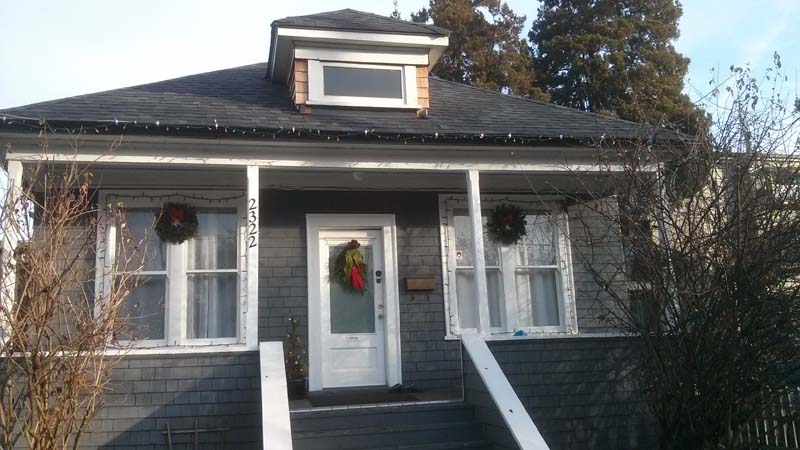
2322 Cypress, an 1897 example with chamfered porch posts.
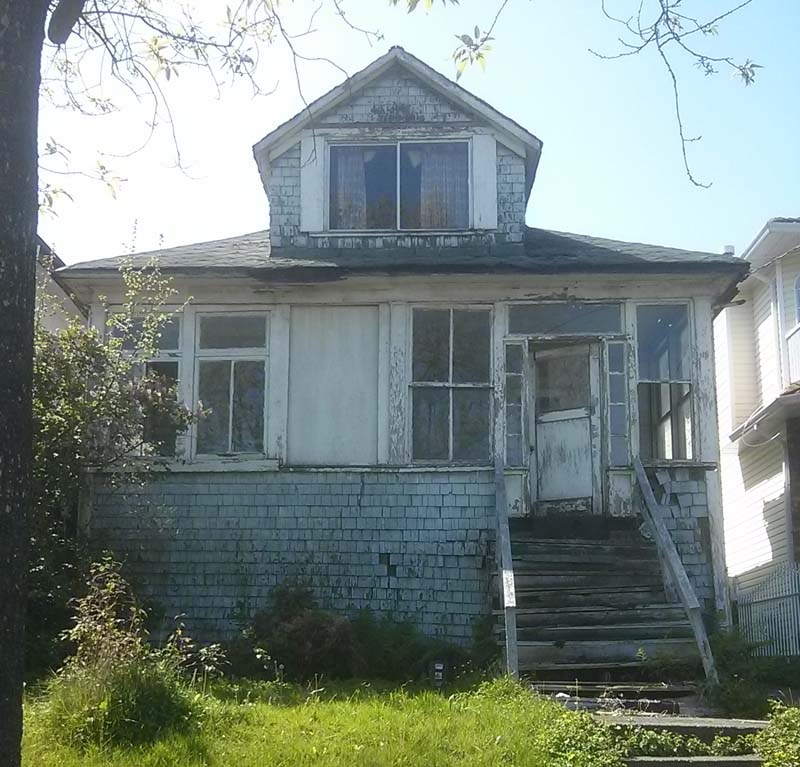
3515 Welwyn Street, with a large dormer to create usable upstairs space and a filled-in front porch.
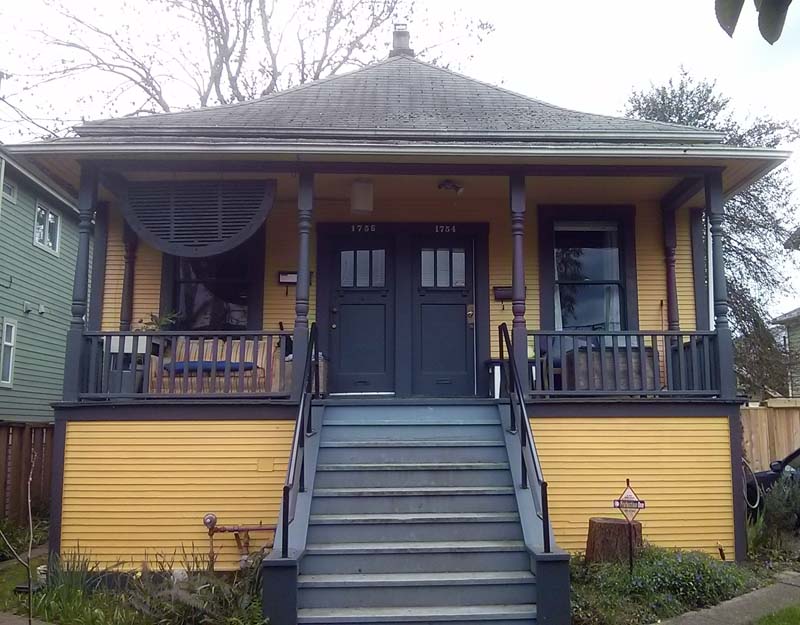
1756 Graveley Street, an example with no dormer and an attached porch, converted to a duplex. Its elaborate turned porch posts are possibly not original.
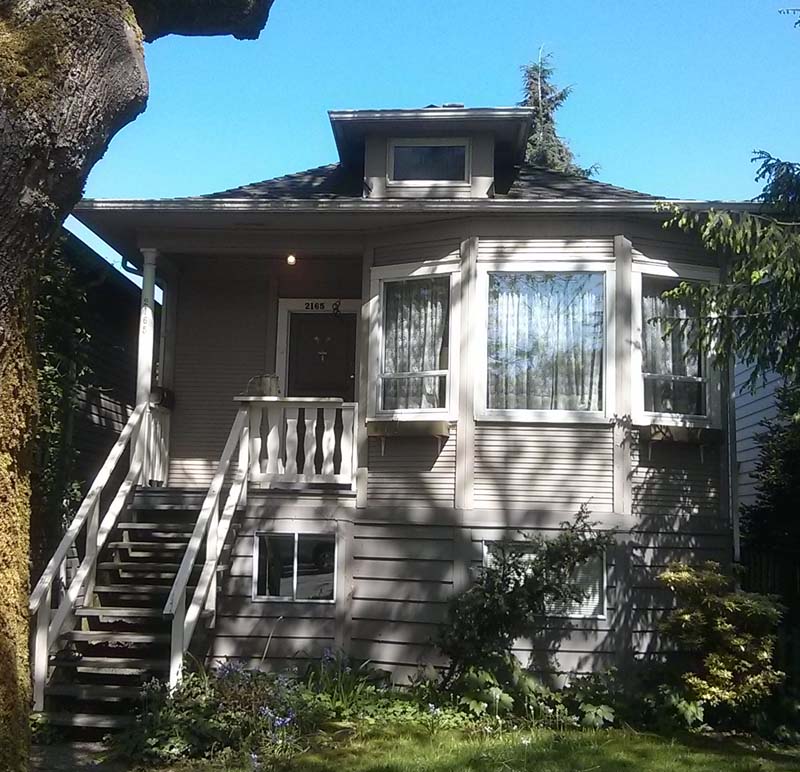
2165 West 13th Avenue, a variant of the style for a narrow, 25-foot lot.
2-1/2-storey form: Tall boxy buildings with a hipped roof and a central dormer, usually with an attached front porch. They are similar, except for the roof, to Gabled Vernacular Style buildings. Some larger examples have an additional half-storey illuminated by the dormers. Porch posts and dentils are similar to the Cottage form above – that is, Classically inspired.
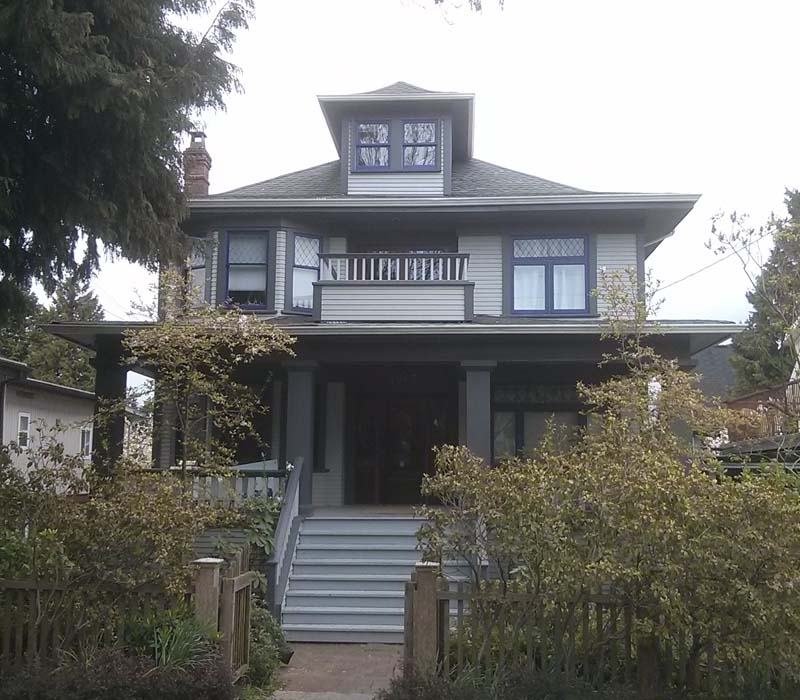
2067 East Georgia Street
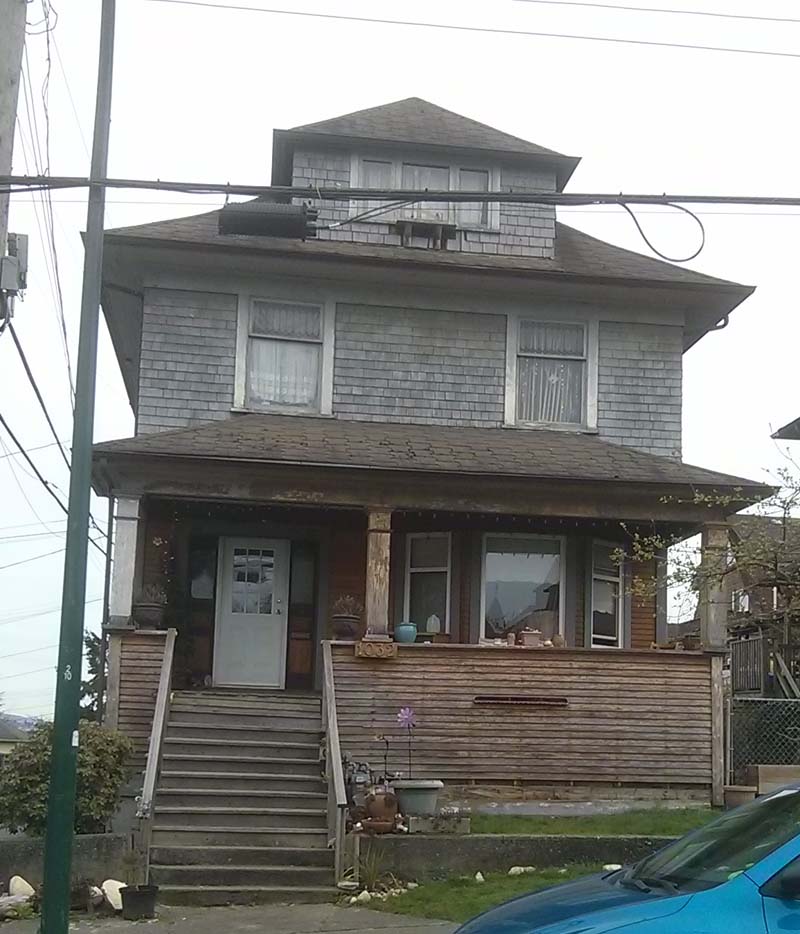
1032 Lakewood Drive, with square porch posts, lap siding on the main floor and shingling above.

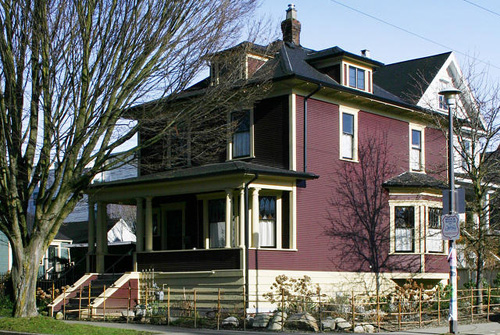 750 Princess, round (Tuscan) porch posts
750 Princess, round (Tuscan) porch posts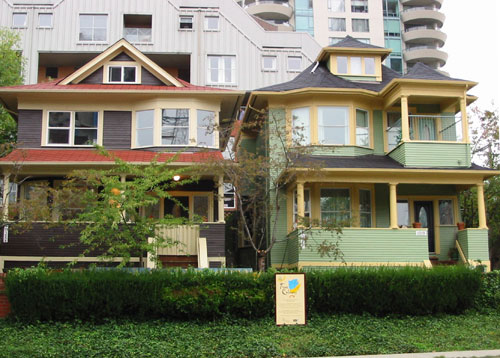 1019
- 1025 Pacific
1019
- 1025 Pacific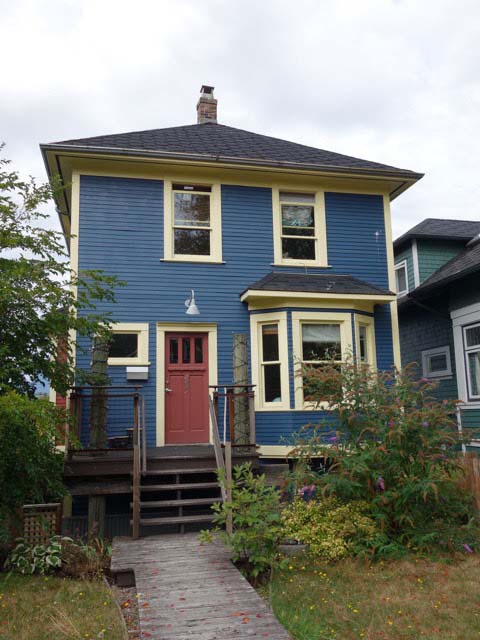
2038 Parker, a rare example of a "Foursquare" – 4 rooms on the main floor and 4 on the second, with a pyramid roof.
Queen Anne (1886 - 1915)
These now-uncommon houses have asymmetrical multi-storey profiles with a turret – that is, a projecting bay, often hexagonal or octagonal, extending from the house walls and topped with a pointed roof that might be hipped or conical. The house’s main roof may be gabled or hipped. Many are clad in a variety of textures, including fishscale shingles and narrow board siding. Porches may have a pediment in line with the front door and posts with elaborate fretwork brackets (“gingerbread”).
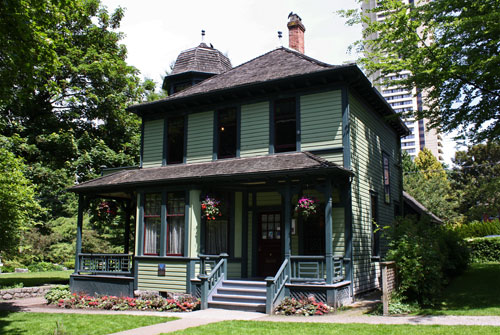 Roedde House
Roedde House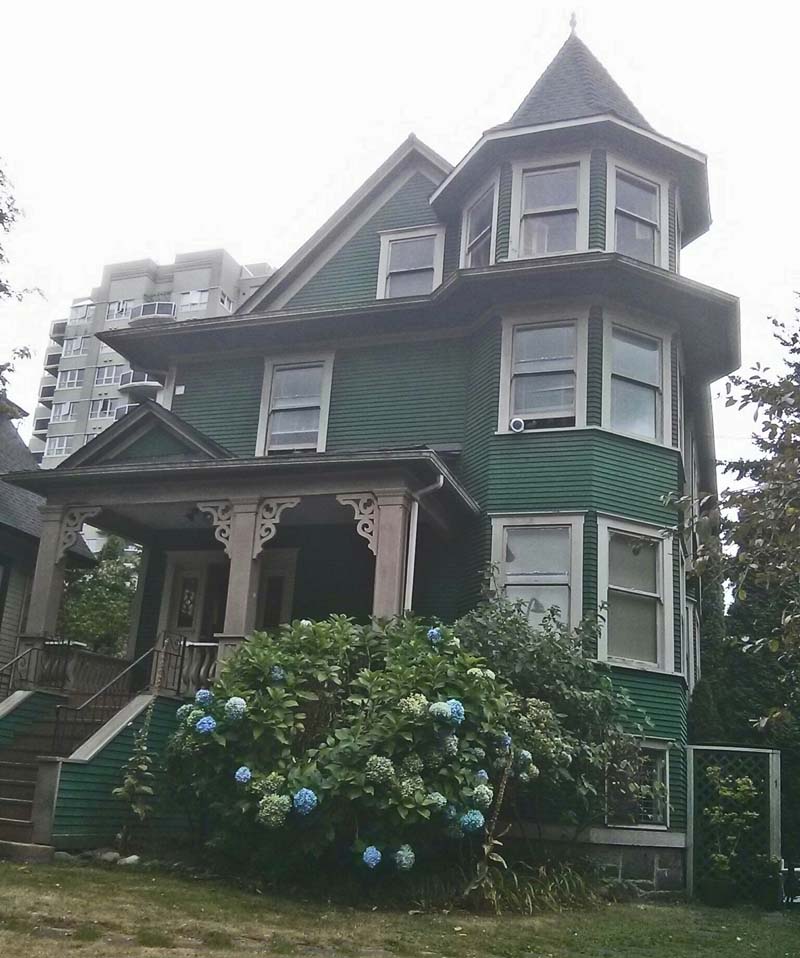
1822 East Pender Street, with a half porch, a pediment in line with the front door, and elaborate fretwork ("gingerbread") brackets on the porch posts.
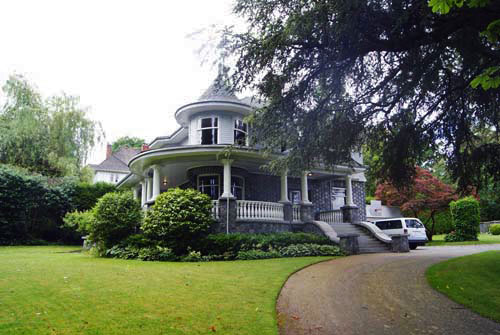 1612 Cedar Crescent
1612 Cedar Crescent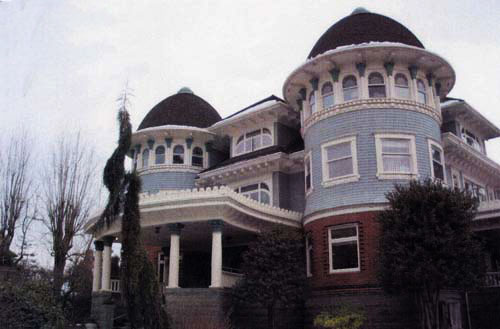 Glenbrae, now known as Canuck Place
Glenbrae, now known as Canuck Place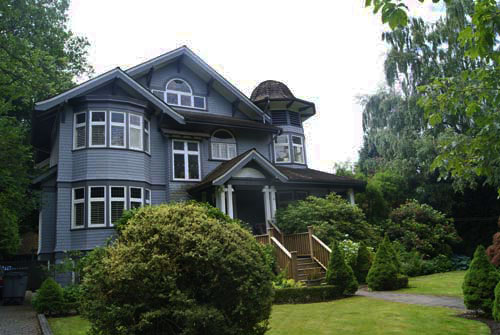 1938
West 19th
1938
West 19thCraftsman (1905 - 1925)
Craftsman is the American Arts & Crafts Style, mostly identified with Southern California and arriving in Vancouver about 1908-10. Easily identified by its prominent knee brackets and, typically, the amount of exposed structure such as rafter tails and purlins. The best examples have stone or clinker brick for foundations, porch piers and chimneys. Shingles are the usual cladding and give them a rustic look. There are three types:
Front-Gabled single-storey Craftsman cottages
“California Bungalows” (1910 - 1930)
The purest style, occurring mainly in Kitsilano, is a bungalow with a low-pitched roof and integral porch, small attic window, clinker brick or stone porch piers with no middle post, and occasionally a mock-Japanese flair in carved fascia boards and clinker-brick chimneys.
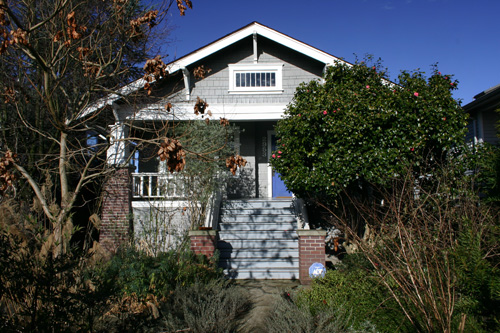 2953 West
5th
2953 West
5th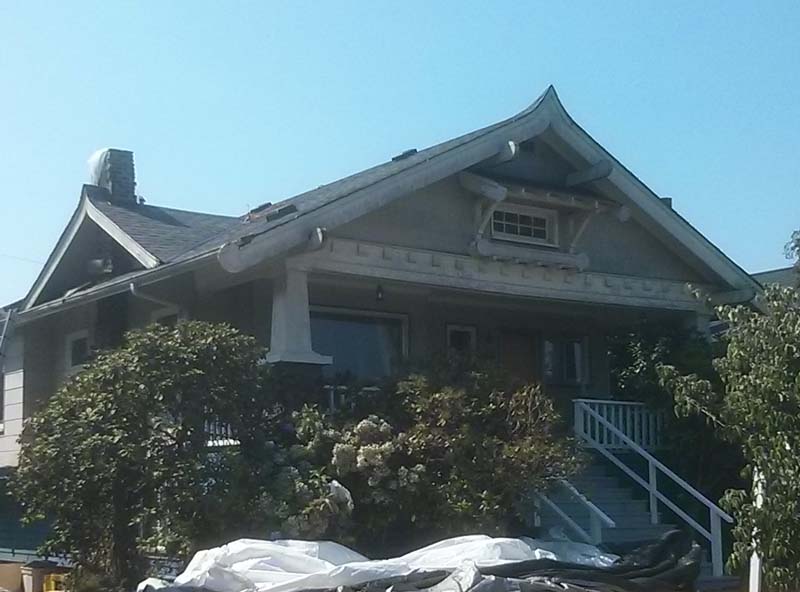
2970 West 5th, a 1919 bungalow with clinker-brick porch posts and chimney, a flared, pointed, roof apex and scroll-cut fascia boards and purlins in the Japanese style.
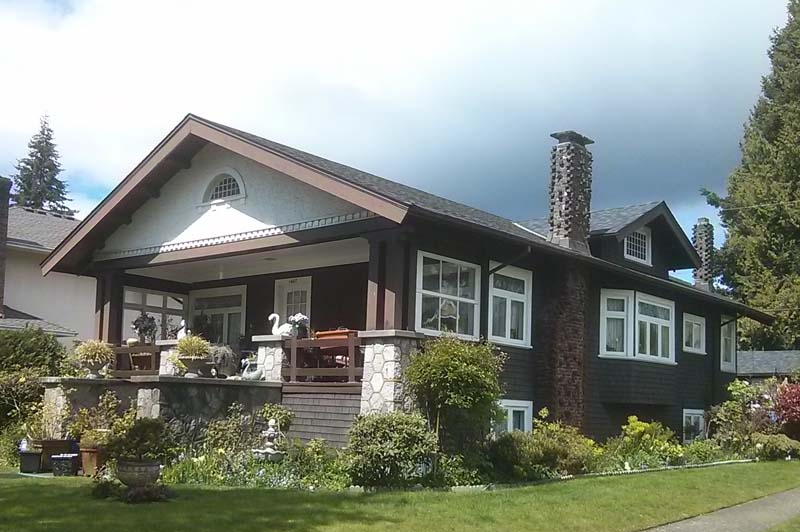
1407 West 53rd Avenue, with exposed purlins, granite porch foundations and clinker-brick chimneys.
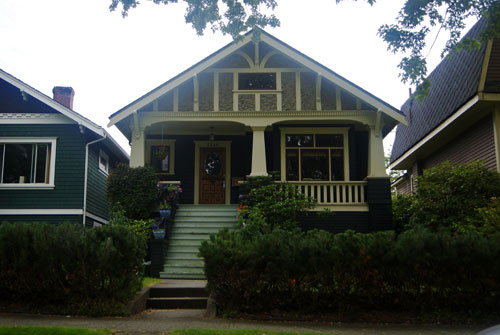 2640
Oxford, with a middle porch post and half-timbering in the gable.
2640
Oxford, with a middle porch post and half-timbering in the gable.On the East Side, most Craftsman cottages have a simple single gable with knee brackets, sometimes with a nested gabled bay, also bracketed, providing a half porch.
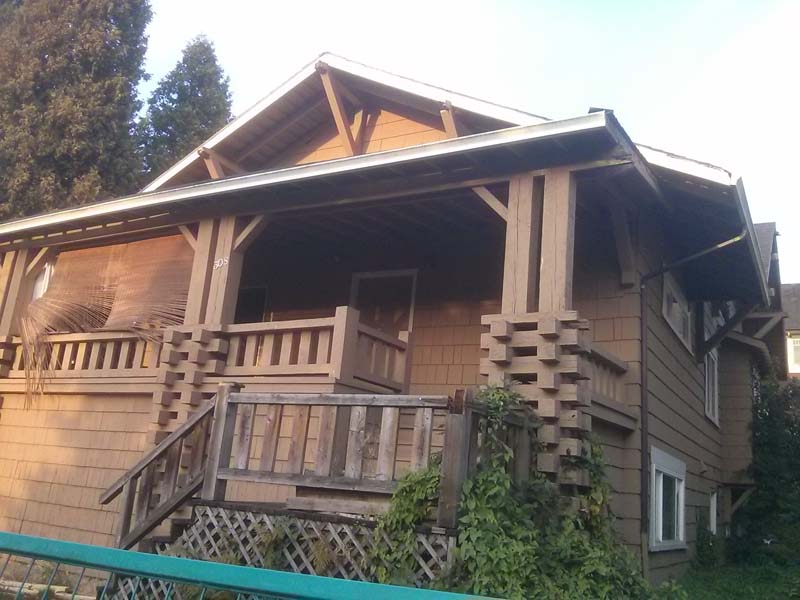
308 Lakewood, a sprawling bungalow with an attached porch and wooden porch posts imitating the texture of clinker brick.
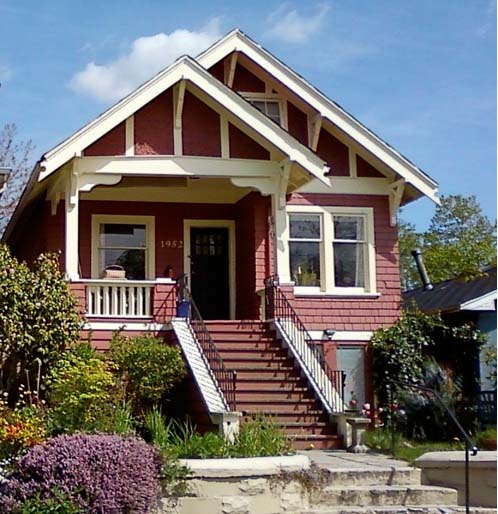
1952 Lakewood, a 1912 Craftsman house with carved fascia boards, knee brackets, scroll-cut brackets, shingle cladding and half-timbering with rough-cut stucco in the gables
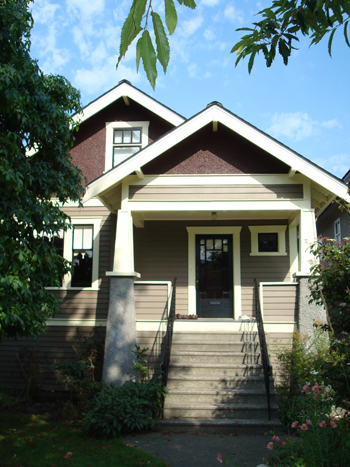 2543
Pandora, Craftsman form but with false purlins rather than brackets.
2543
Pandora, Craftsman form but with false purlins rather than brackets.Front-gabled 1-1/2 to 2-1/2 storey Craftsman houses have a boxy building shape (very similar to the Gabled Vernacular Style) with an attached front porch with square piers, knee brackets and usually a shed roof; shed-roofed dormers and projecting bays on side elevations are also typical. Common in Kitsilano and Grandview.
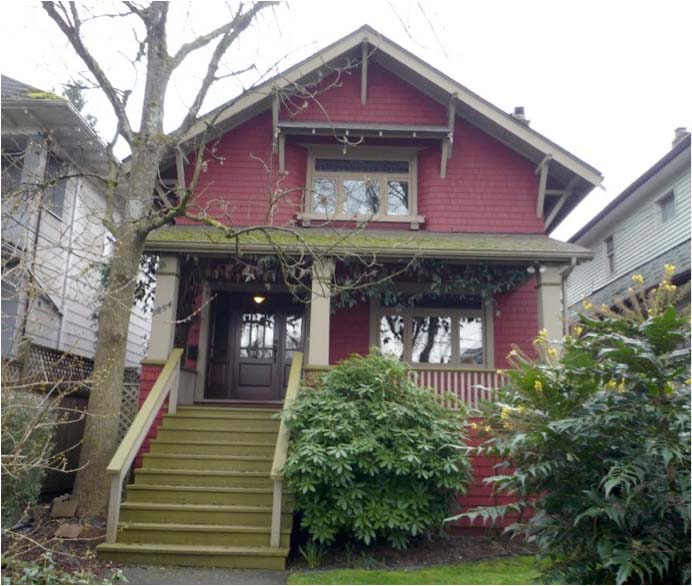
1854 William, with square porch posts, knee brackets, exposed rafter tails and shed roofs on the porch and on the small roof above the window in the gable.
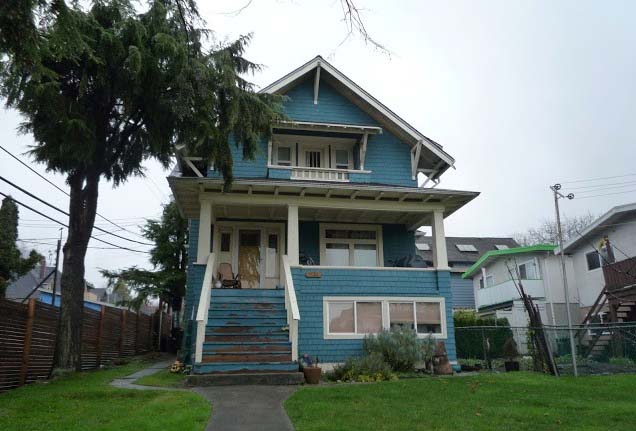
1132 Salsbury Drive, with a shed roof supported by knee brackets sheltering its sleeping porch and exposed rafter tails.
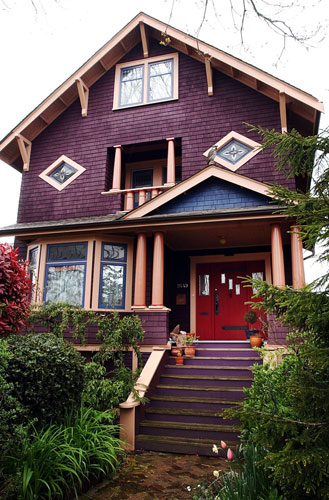 2449 Dundas
Street, a hybrid with Craftsman knee brackets but the turned columns
and pediment of the Colonial Revival Style.
2449 Dundas
Street, a hybrid with Craftsman knee brackets but the turned columns
and pediment of the Colonial Revival Style.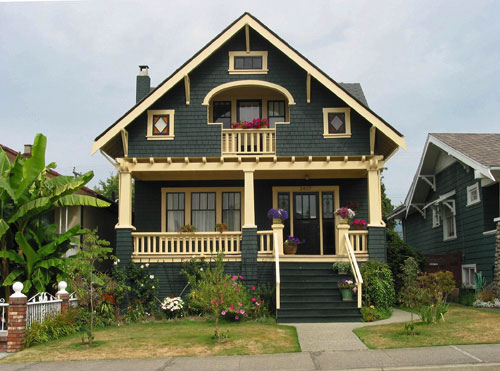 Dundas Street,
another hybrid, with the integral porch of the Edwardian Style but
Craftsman detailing.
Dundas Street,
another hybrid, with the integral porch of the Edwardian Style but
Craftsman detailing.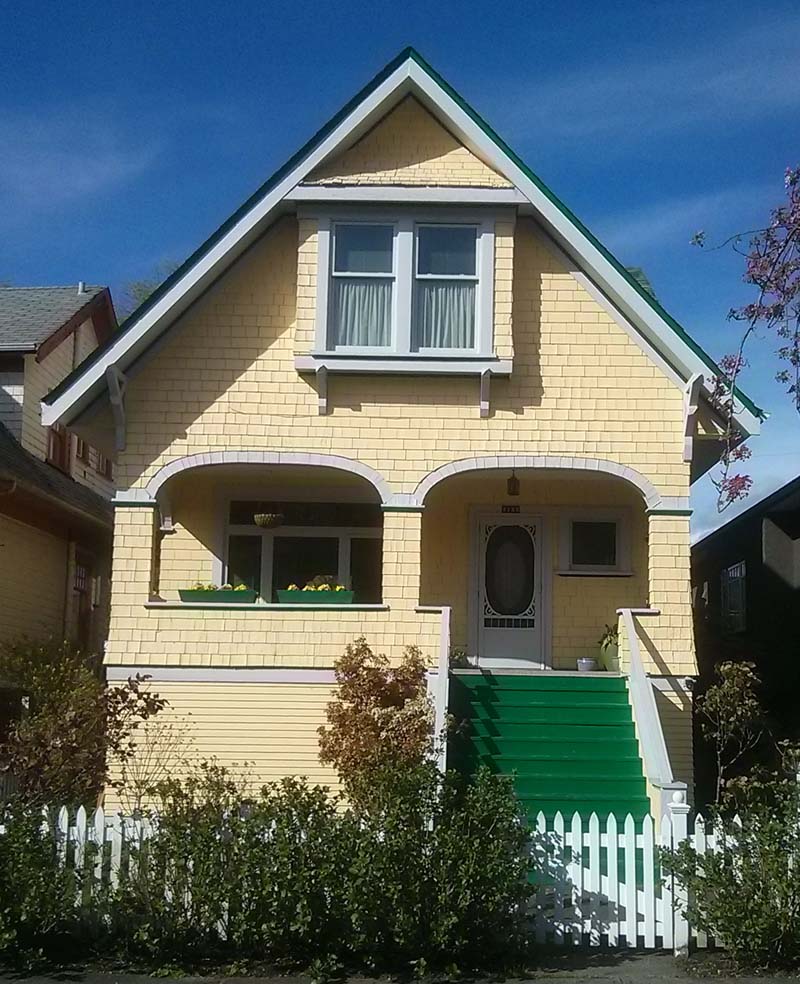
2129 Graveley Street, a hybrid, with Craftsman-style brackets but an Edwardian integral porch.
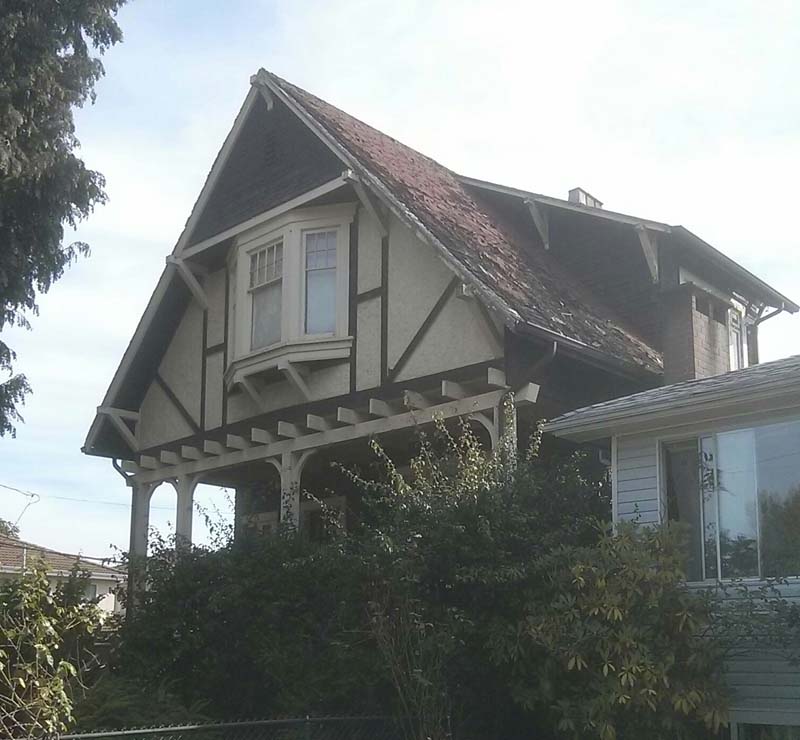
4750 Windsor, a Craftsman in every respect except for the Edwardian-style integral porch.
Side-gabled Craftsman houses (sometimes called “Swiss Cottages” or “Swiss Chalets”) are usually 1-1/2 storeys with a very prominent roof covering an integral porch and a sleeping porch set into the roof on the front elevation within a shed-roofed or gabled dormer or dormers. They have wide eaves, knee brackets and robust square porch posts with brackets; elaborate examples have stone or clinker-brick foundations or porch posts; shingle-siding is typical above the water board; the exterior chimney is often of clinker brick. The style is most common in Kitsilano.
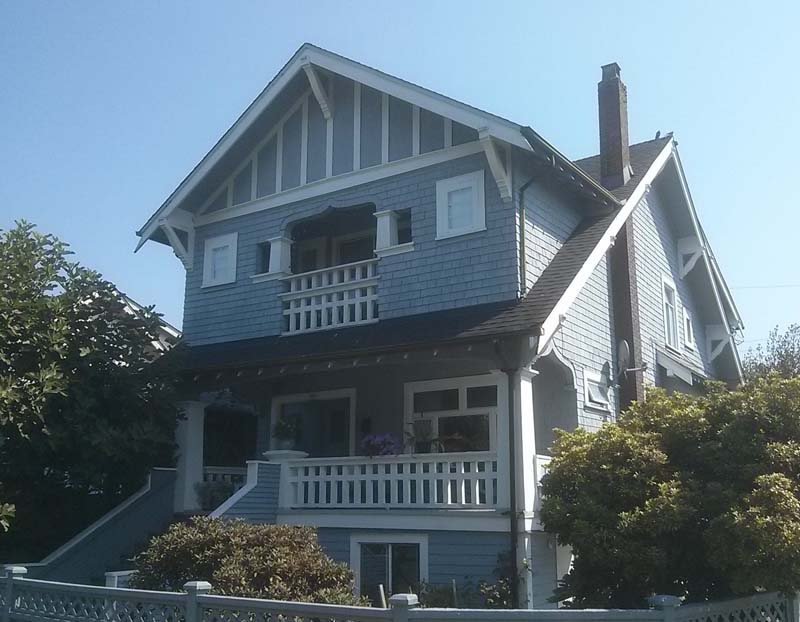
2050 Macdonald, with a side-gabled roof and integral porch, a gabled dormer with a sleeping porch, half-timbering, knee brackets, exposed rafter rails and elaborate shingling.
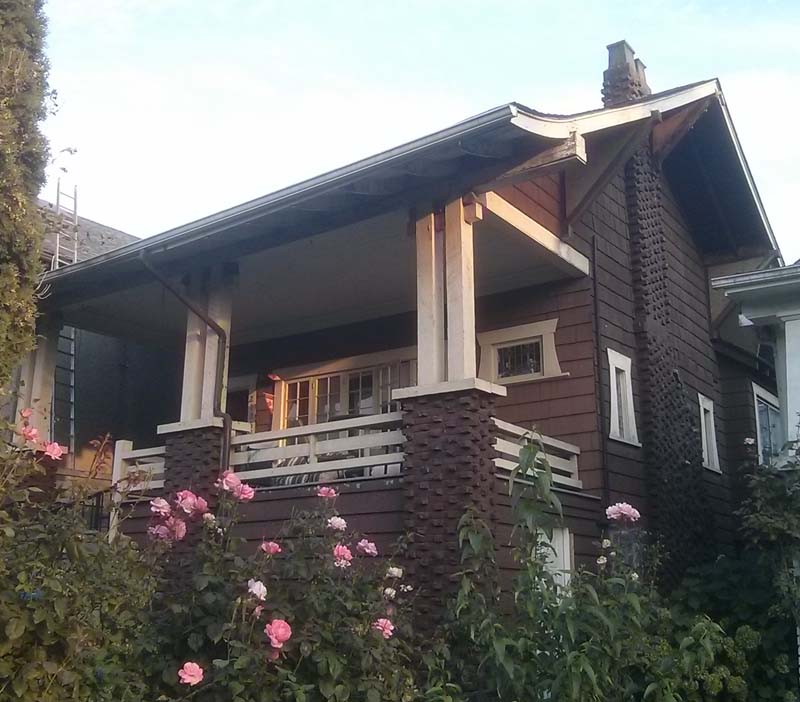
2136 Franklin, a side-gabled Craftsman with clinker-brick porch posts and chimney, a bell-cast roof over the porch, curved rafter tails and Japanese-style window framing.
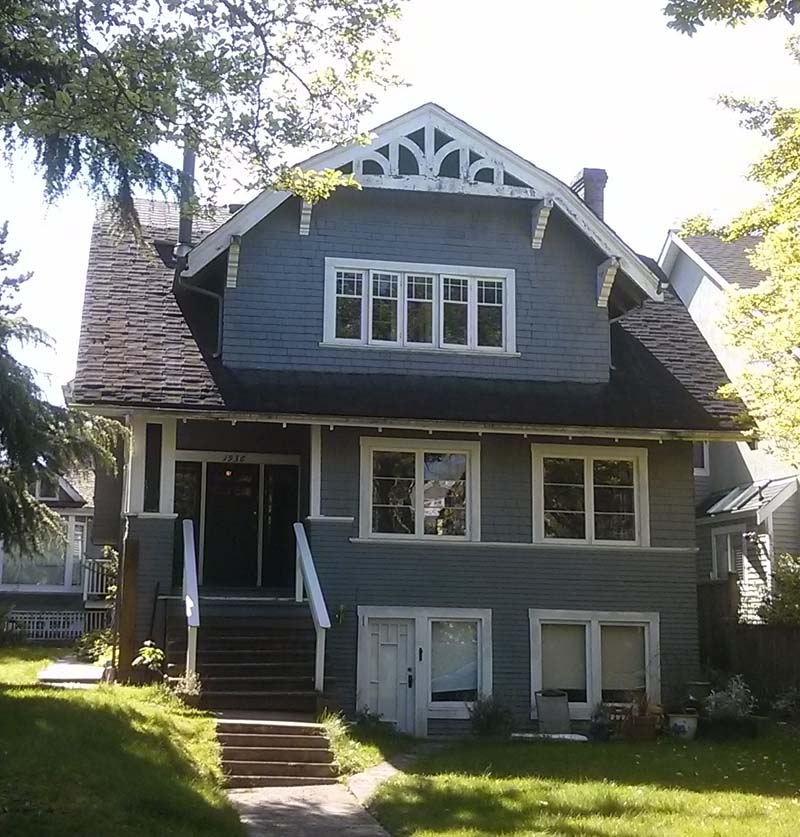
1936 West 14th Avenue, with an altered basement level and filled-in porch, plus an unusual gambrel-roofed dormer with decoration in the style of half-timbering.
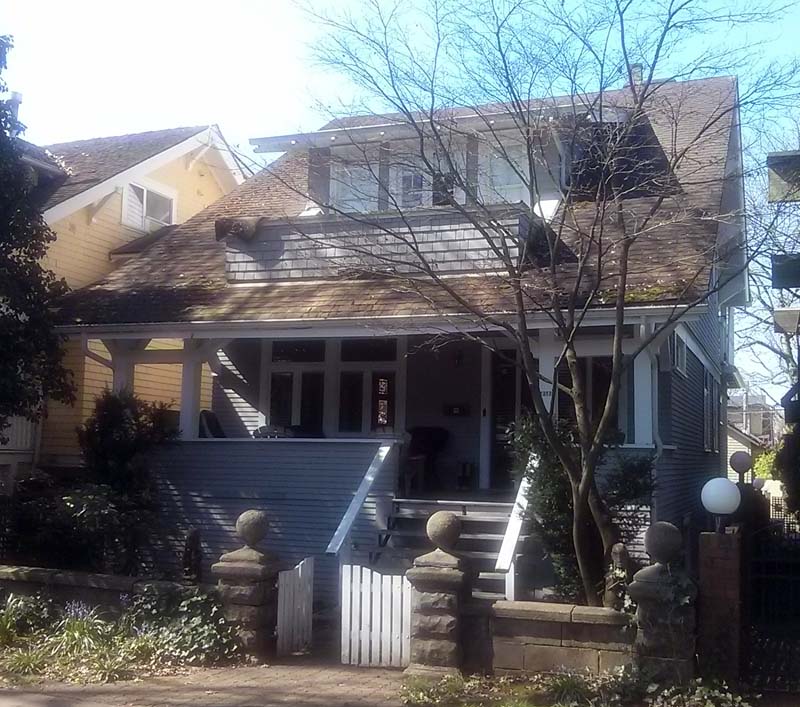
1317 Walnut Street, with an integral porch, paired square porch posts and a sleeping porch with a shed-roofed dormer.
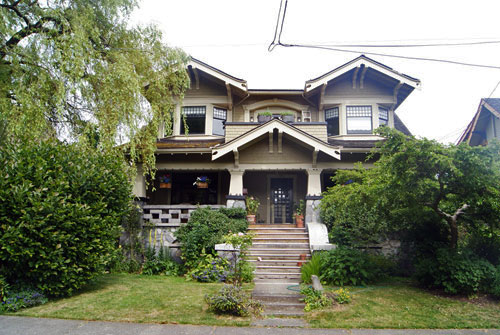 Dunbar
Street in northwest Kits, an elaborate example with a pediment
framing the front door.
Dunbar
Street in northwest Kits, an elaborate example with a pediment
framing the front door.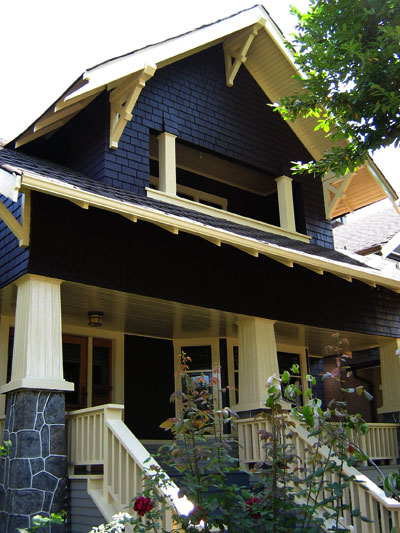 2538
Balaclava, with prominent knee brackets and exposed rafter tails.
2538
Balaclava, with prominent knee brackets and exposed rafter tails.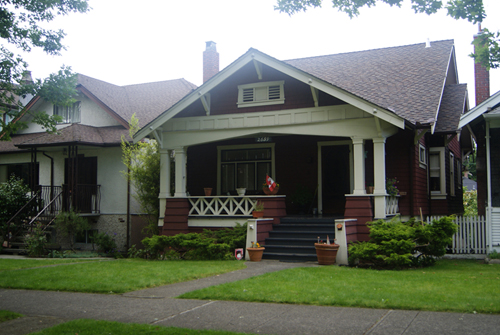
2659 Oxford, a variation with paired square posts on an attached, gabled porch.
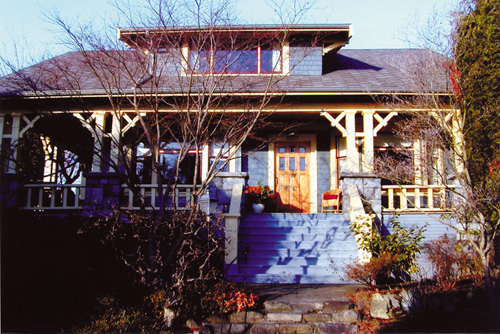
3223 West 37th, with bold brackets on the paired porch posts and a shed-roof dormer illuminating the half storey above.
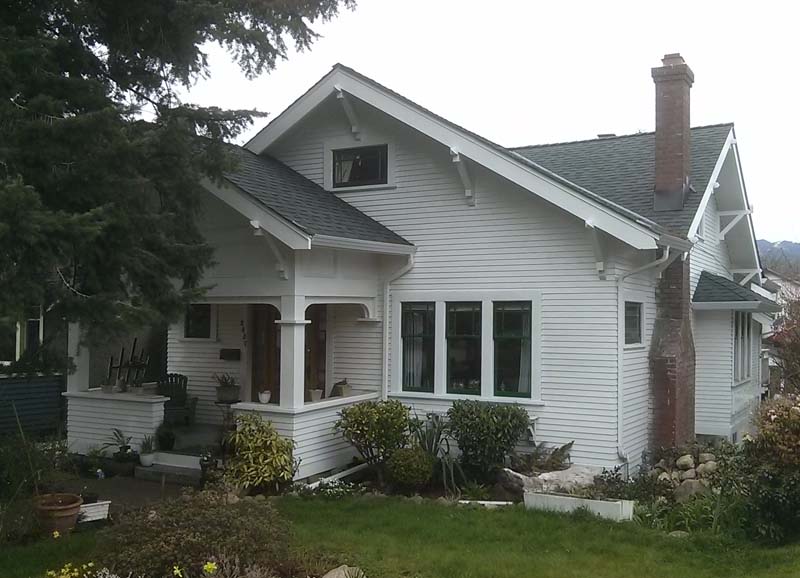
2057 Napier Street, a 1920s example set very low to the ground on a sloping lot.
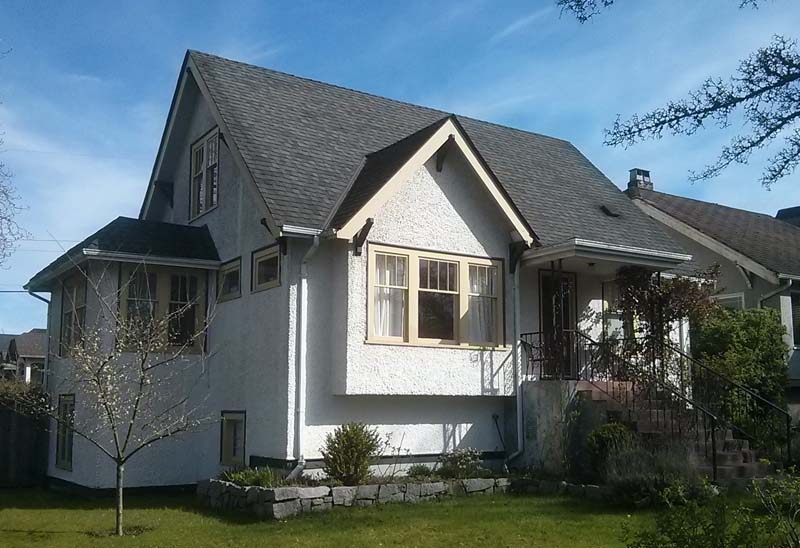
1412 Kamloops Street, where the Craftsman style remains only in the knee brackets.
Edwardian (1905 - 1913)
The only style in Vancouver that began and ended in the Edwardian period, c. 1901 - 1913. They are 1-1/2 storey with a very steep-pitched front-gabled roof above an integral porch and (typically) saddle-bag dormers; the roof skirt gives a strongly triangular look to the gable and usually frames a sleeping porch; the staircase and front door are typically placed on one side; a triple window with a transom illuminates the living room on the other side; some feature decorative shingling, such as strips of diamond-pattern shingles in the gable; brackets are much less prominent and structural than in the Craftsman Style, and typically are carved and set flat along the soffits. However, some Edwardian-style houses have hybrid-Craftsman features such as knee brackets.
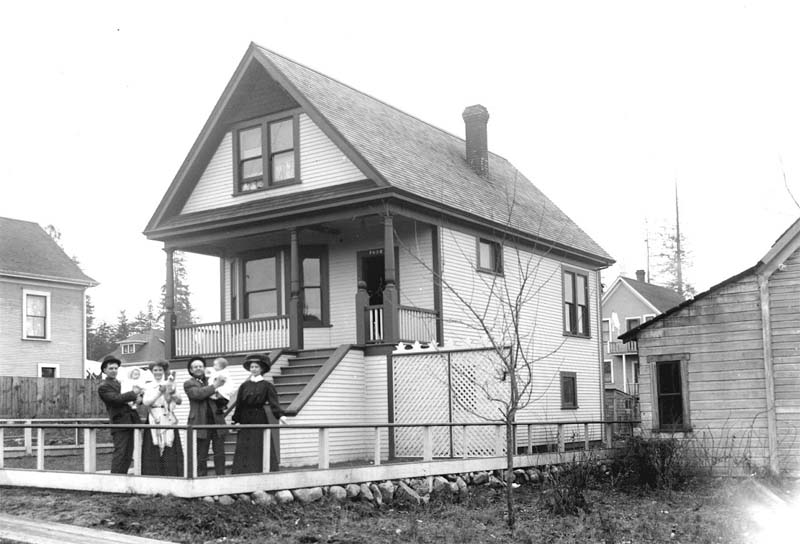
1928 Grant, a very simple example of the style with an integral porch, shingling at the top of the gable, and no dormers.
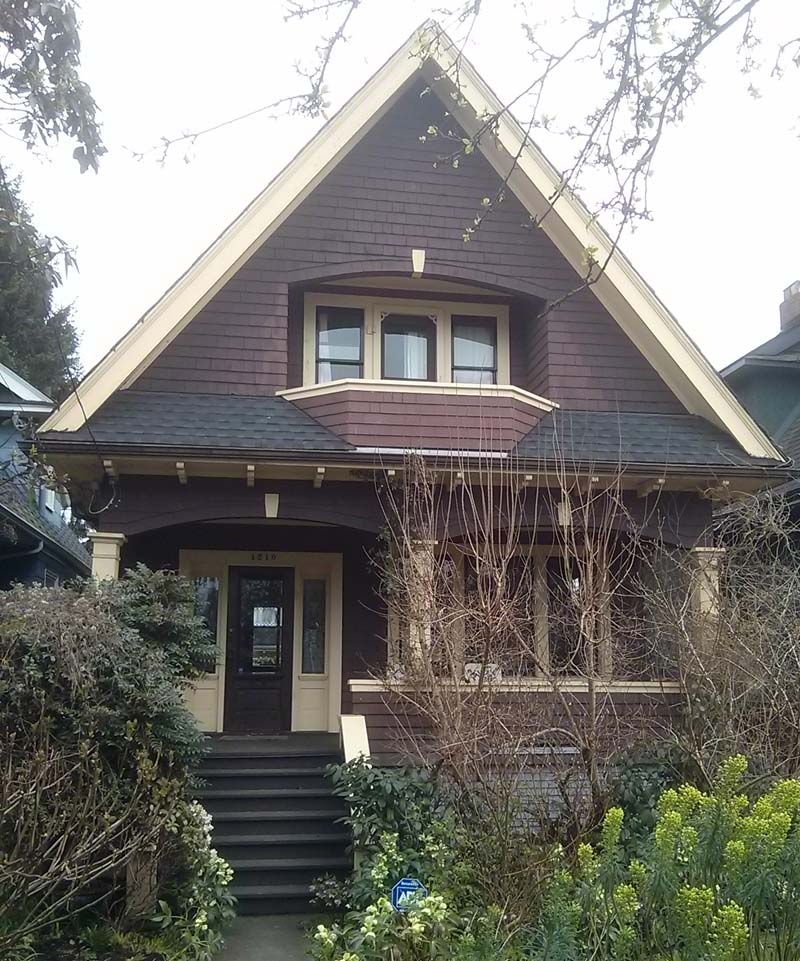
1210 Lakewood Drive. Note the decorative carved brackets attached to the soffits.
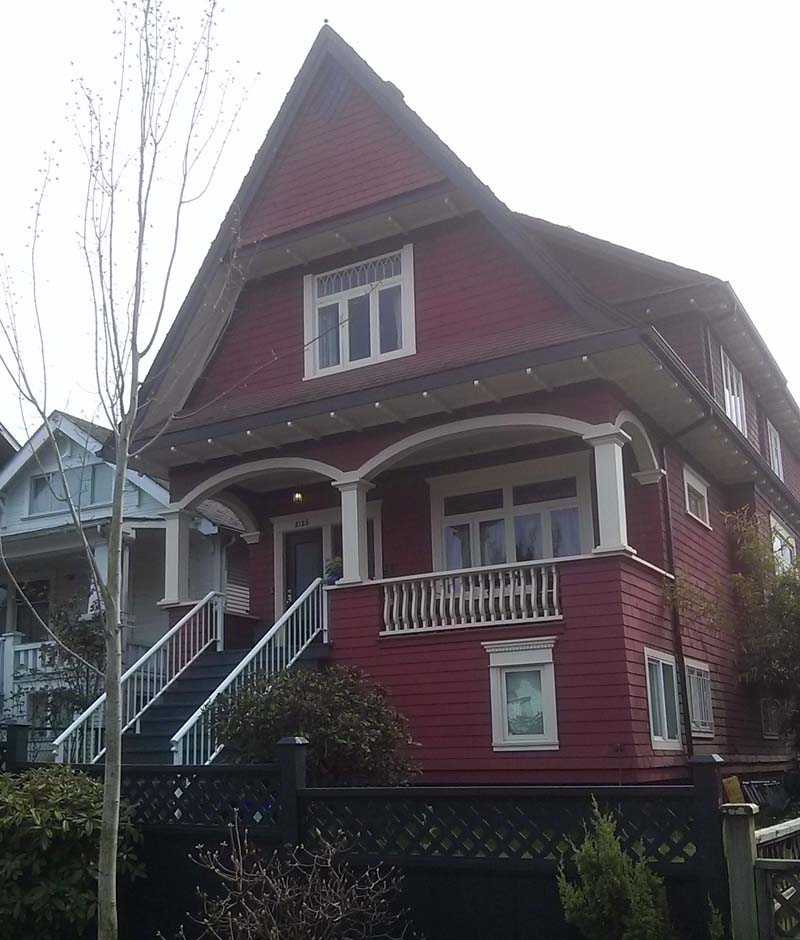
2126 Franklin, with saddlebag dormers and carved brackets.

Graveley at Woodland, with elaborate saddlebag dormers
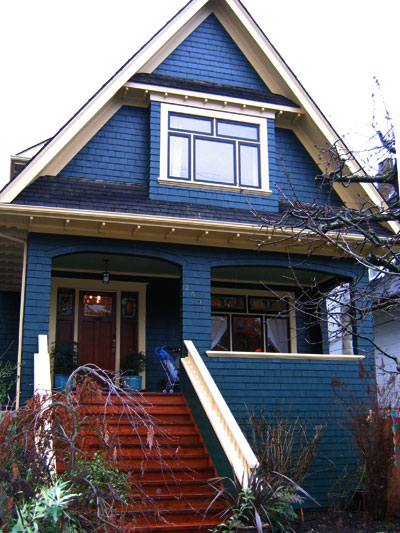 2650
West 5th
2650
West 5th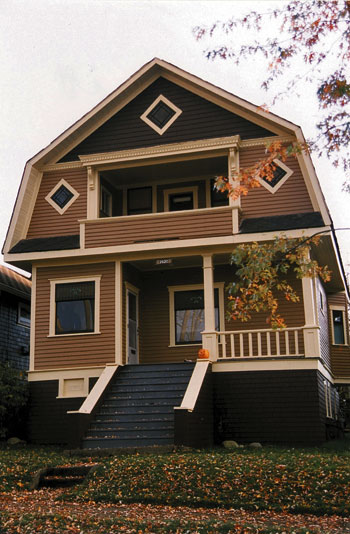
2620 Oxford, a hybrid with a gambrel roof
Arts & Crafts (1910 - 1930)
Asymmetrical, picturesque houses, mostly pre-WWI, with steeply pitched hipped roofs. They are usually set low to the ground and often featuring multiple and prominent chimneys and half-timbering on their upper floors; windows are typically leaded glass in small panes, often set in multiple assemblies. They are in the English Arts & Crafts tradition, while Craftsman houses come from the American Arts & Crafts tradition. Architect Samuel Maclure’s grand mansions of the Edwardian era are the best representatives of the Arts & Crafts Style in British Columbia. They have more a "sheltering roof," more of a horizontal form, than Tudor Revival Style houses.
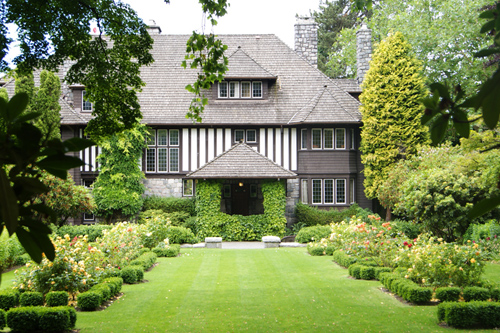 1402 The Crescent
1402 The Crescent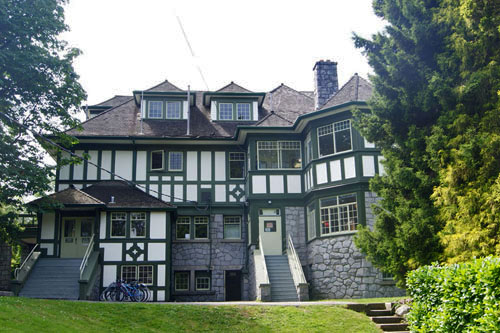 4397
West 2nd, Aberthau (rear view)
4397
West 2nd, Aberthau (rear view)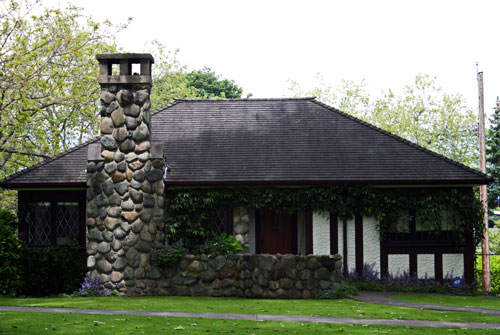
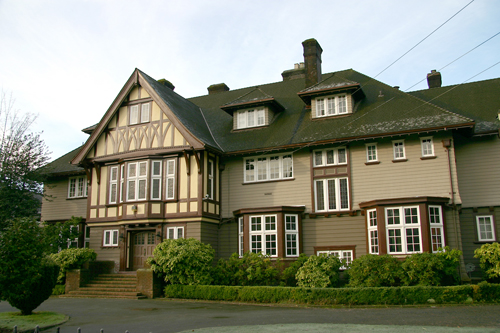
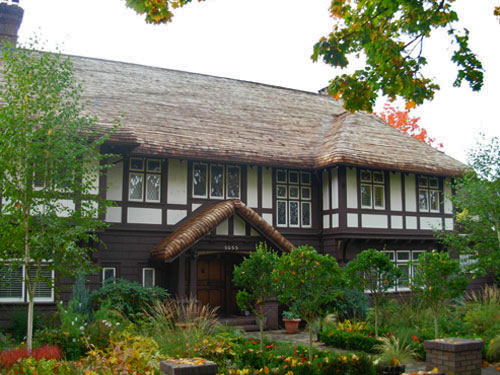 5055 Connaught Drive
5055 Connaught DriveInterwar Arts & Crafts (1920 - 1940)
Modest variants on the grander houses before WWI, they mostly feature jerkinhead roofs, very often on a side gable, with a projecting bay (also with a jerkinhead roof) facing the street, half-timbering, and windows often set in 3s.
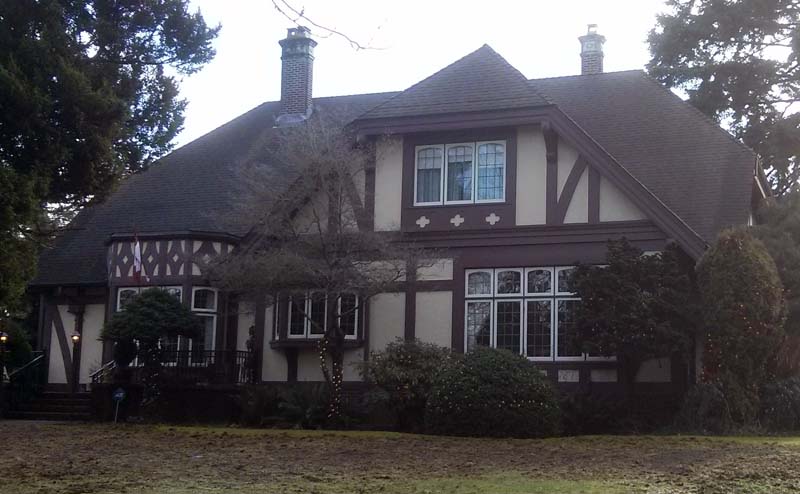
1710 West 38th Avenue, with jerkinhead roof on the side gables and front bay, and elaborate half-timbering.
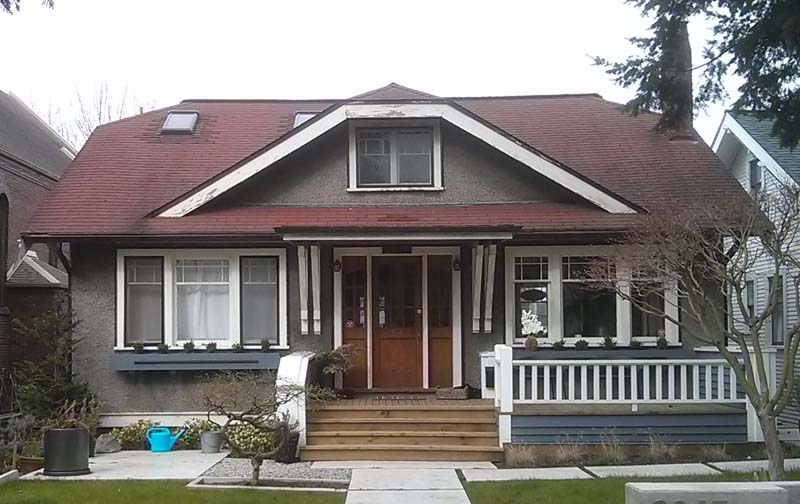
2047 Napier Street, with large brackets holding up a flat roof above the front door.
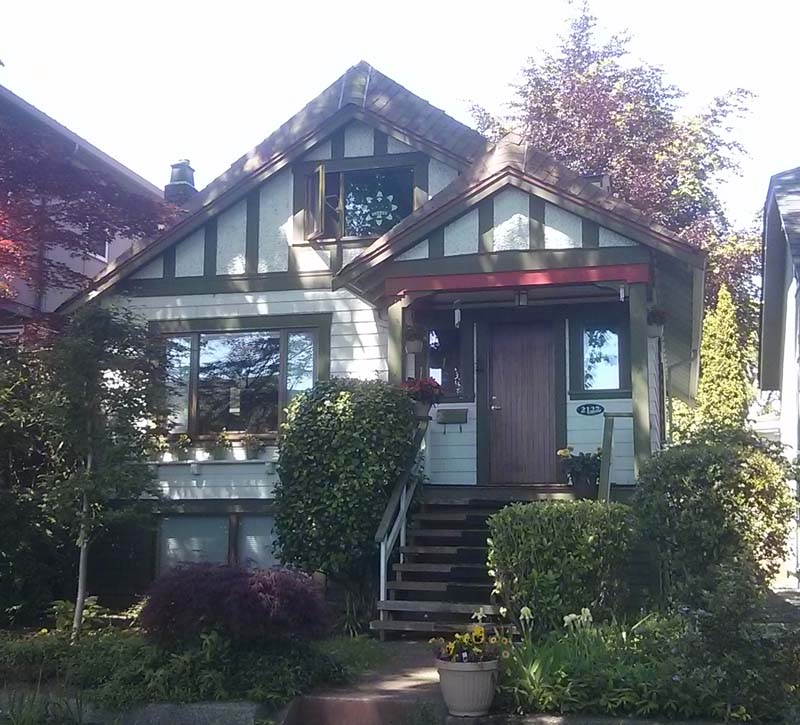
2127 East 7th Avenue, a variant with half-timbering in the gables and an unusual rolled shingle roof imitating a jerkinhead form.
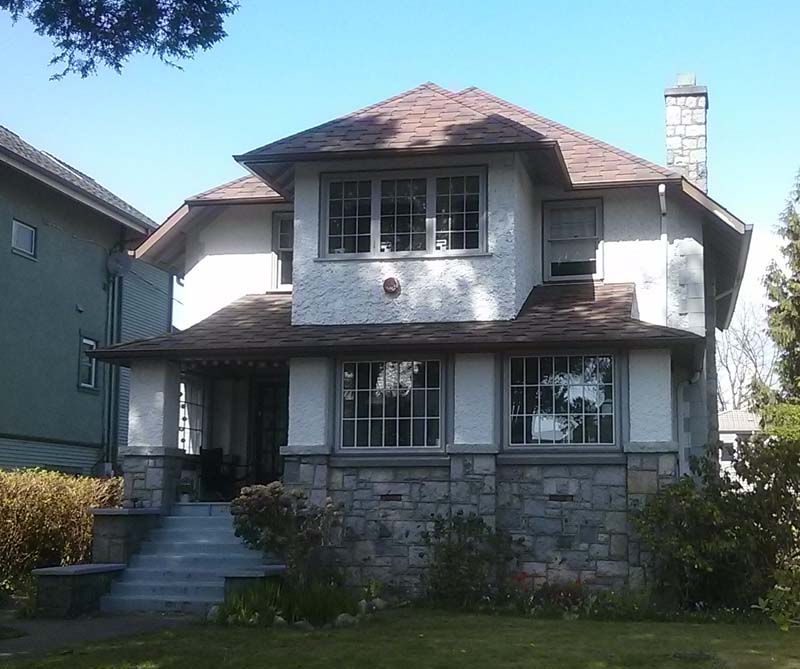
2285 East 3rd Avenue, designed by Sharp & Thompson in 193?, with a hipped-roof bay extending from the main jerkinhead roof.
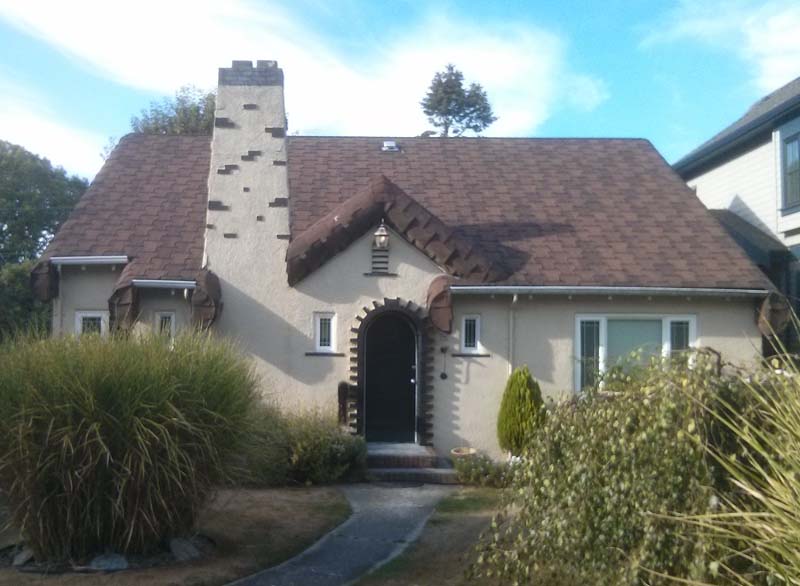
195 West 23rd, an "Olde Worlde cottage" look achieved with a prominent rusticated chimney, rolled eaves and a quoined arched frame around the front door.
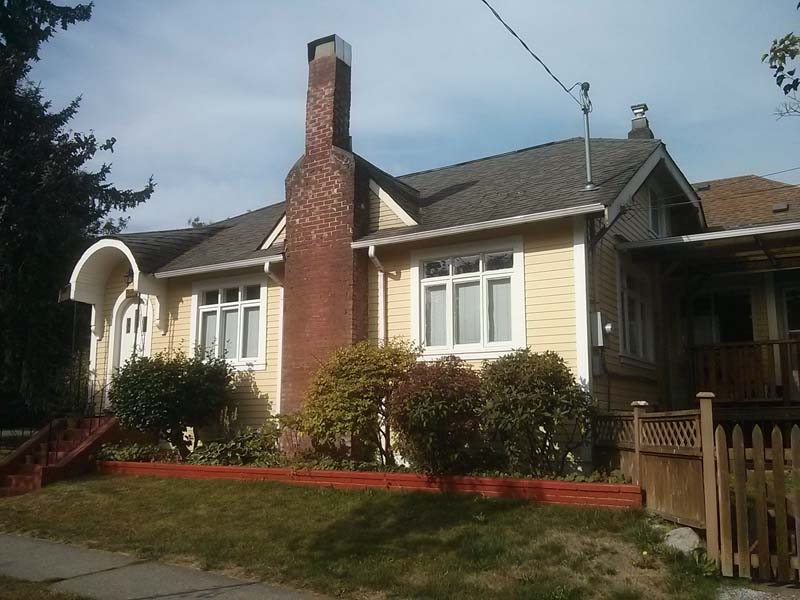
3885 Windsor, with side gables and a jerkinhead roof, an arched pediment over the front door and an oversized "cottage" chimney; it is set sideways on two narrow corner lots.
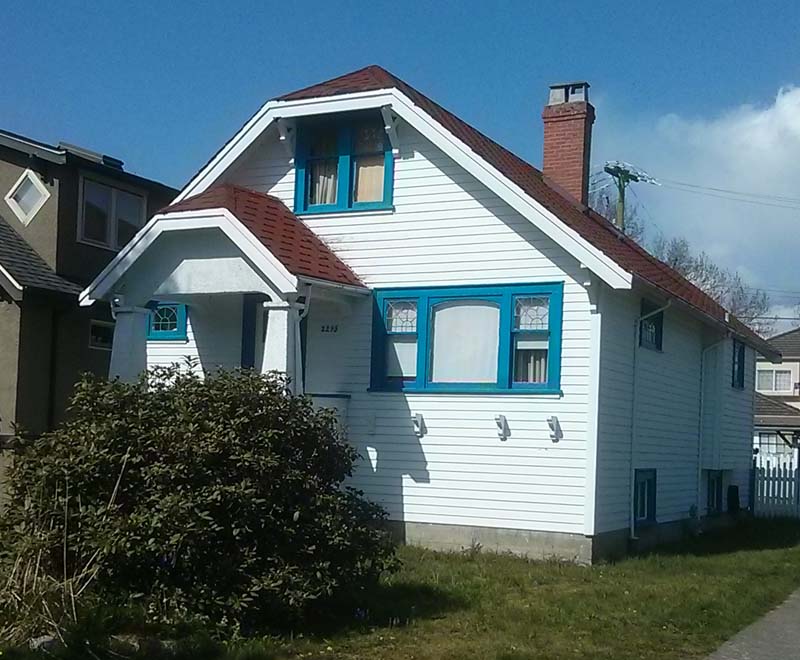
2205 East 11th Avenue, mixing in the ever-popular Craftsman-style knee brackets with the cottage-like jerkinhead roof.
Tudor Revival (1910 - 1940)
Houses with steeply pitched side-gabled or hipped roofs, picturesque profiles, projecting gabled bays or cross gables with half-timbering, and tall chimneys; multiple window assemblies usually include leaded glass, often in diamond patterns. Many pre-World War 1 examples had stone foundations, wooden cladding (shingles or lap siding) on the main floor and roughcast stucco in the half-timbered gable. They are very similar to Arts & Crafts Style houses, but show more gable and half-timbering to the street.
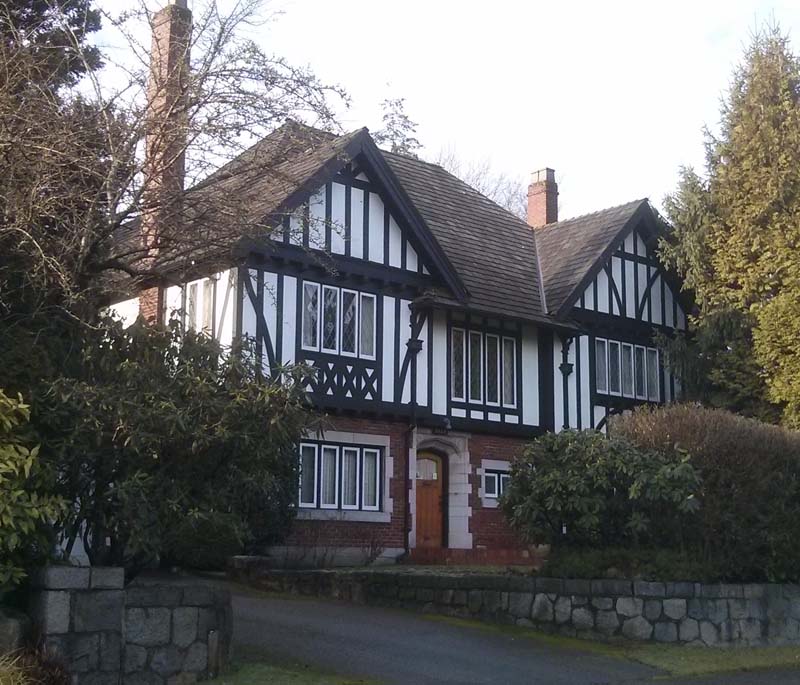
5525 Angus Drive, with quoined masonry framing around the doorway.
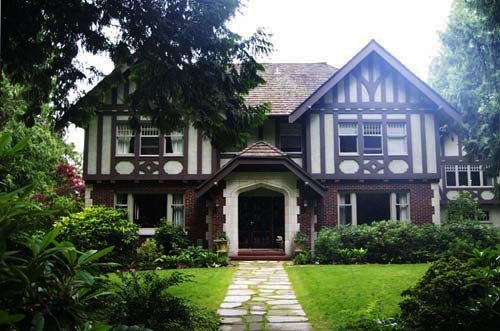 6135 Macdonald, with a jerkinhead roof on the bay containing the
front door and vestibule.
6135 Macdonald, with a jerkinhead roof on the bay containing the
front door and vestibule.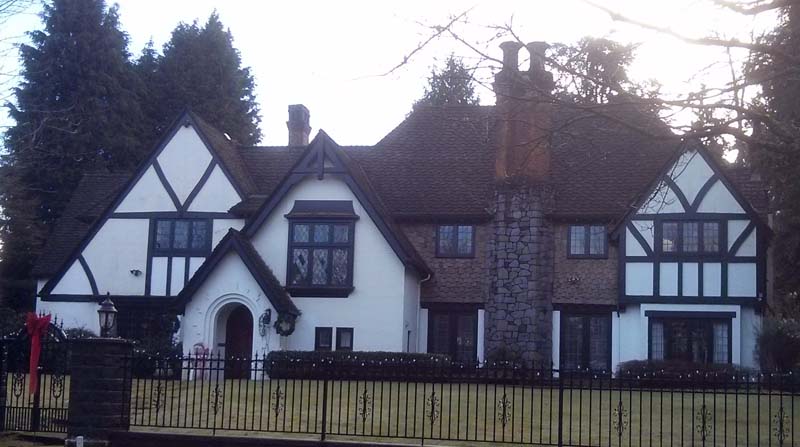
1678 Somerset
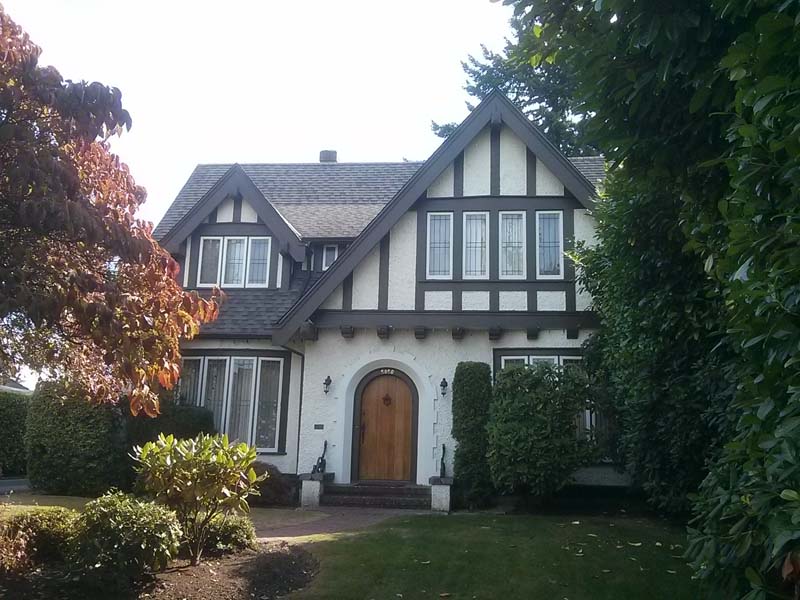
5850 Montgomery, with a cross-gabled roof and bold half-timbering in its gables.
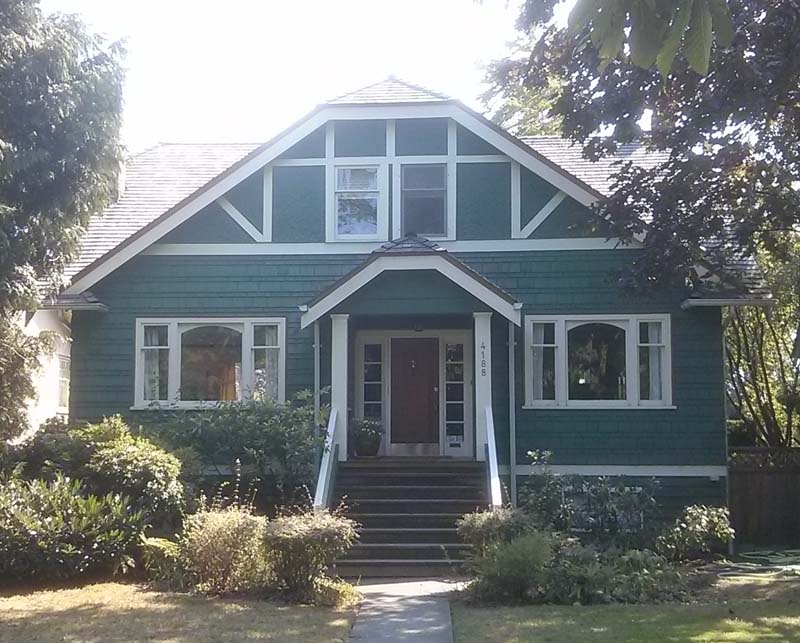
4188 West 14th, with a cross-gabled jerkinhead roof and half-timbering in the gable. The triple-window sets on the main floor, with the arch on the centre one, are common in houses of the 1920s-30s, as are the patterned shingles set in courses of different widths.
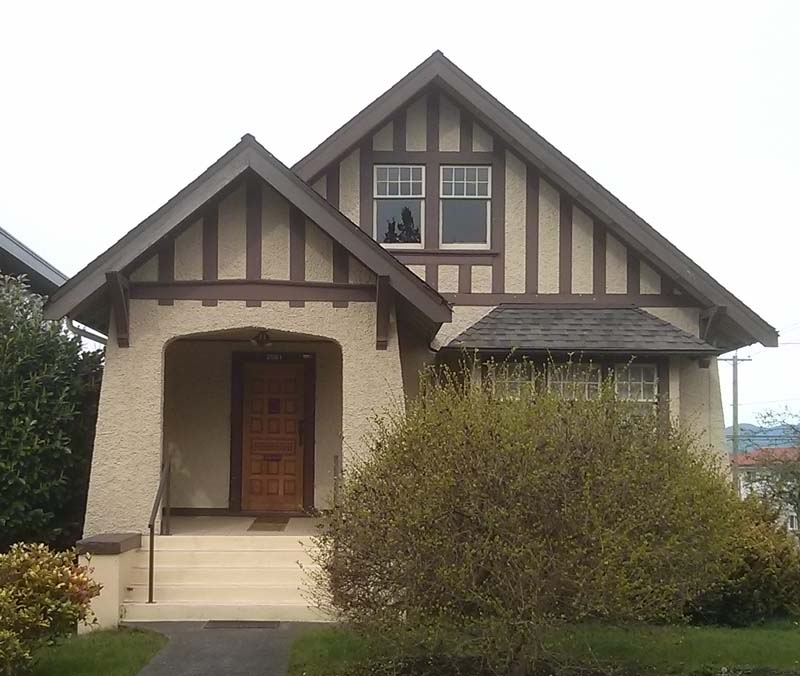
2091 Napier Street, with flared false buttresses on the sides to give the house a triangular, "taller" shape.
Georgian Revival (1920 - 1940)
An interwar style in Vancouver. These are symmetrical two-storey houses with hipped roofs (sometimes pierced with dormers), Classical detailing and, on some wide lots, projecting single-storey side wings with flat roofs and balustrades. Some have a portico sheltering the front door, often supported by columns with a small balustraded deck above. Windows are often grouped in pairs, are vertically proportioned, have wooden muntin bars and are flanked with shutters; fanlights are common above the front door. The main floor is typically at grade; in some cases, a belt course between the two floors defines a projecting upper storey, supported by scroll brackets. Some have pilasters and quoins as well as dentils for added Classical decoration. Cladding may be stucco or lap siding.
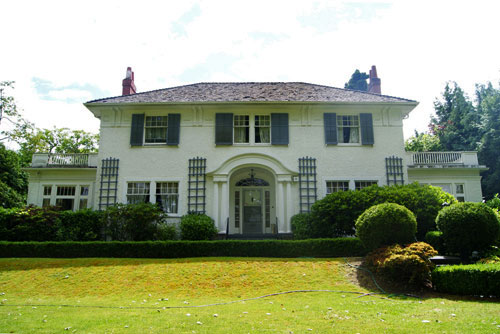 4670 Connaught Drive
4670 Connaught Drive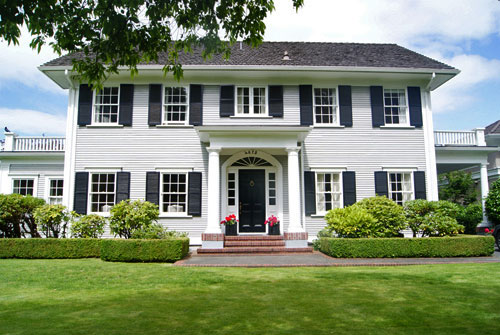 4675 Connaught Drive
4675 Connaught Drive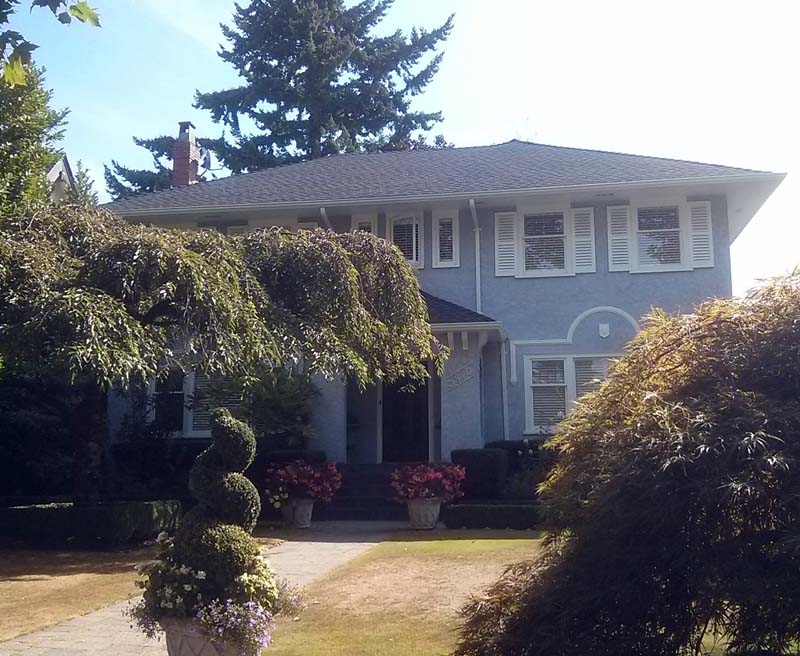
5870 Montgomery, with a hipped roof and symmetrical placement of grouped windows on both floors.
Norman Revival (1920 - 1940)
A comparatively rare interwar style found mainly in South Shaughnessy, with stucco walls, tall leaded windows with shutters, quoined corners, quoined arches over front doors, and a prominent, very steep roof that may enclose a hipped-roof turret or have hipped-roof bays protruding from it.
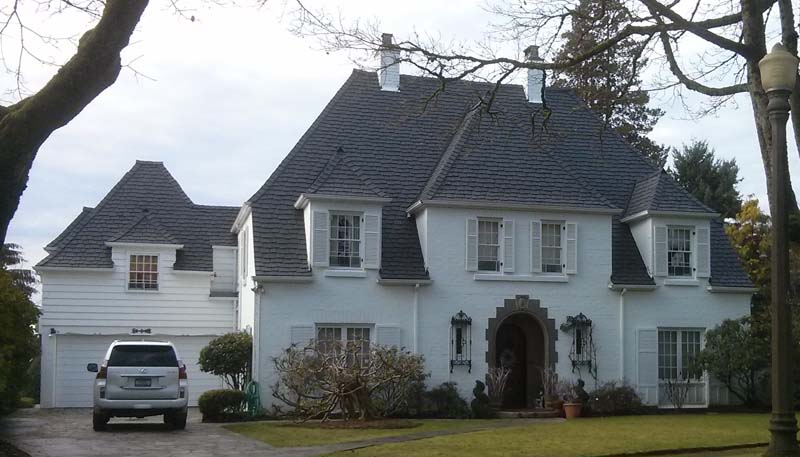
5237 Connaught Drive, designed by architect R.M. Matheson for his own family.
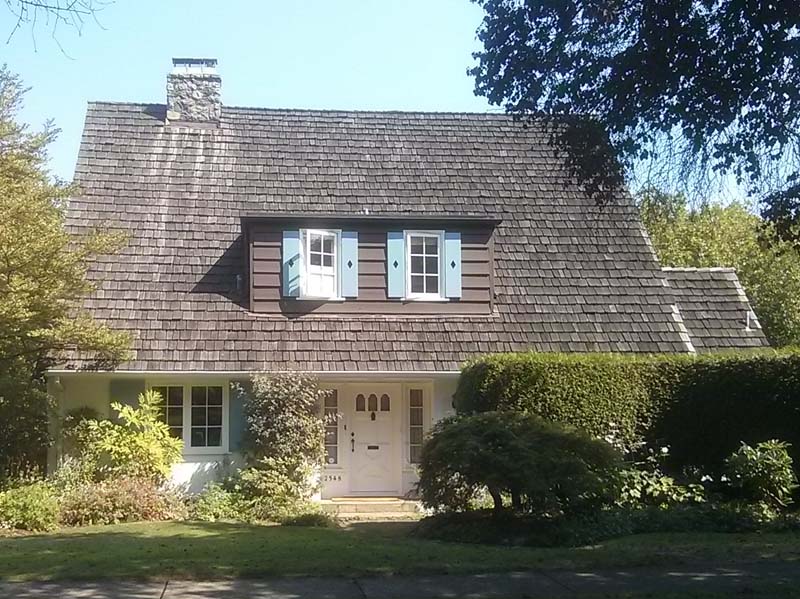
2548 Wallace, a builder's variant of the style.
English Storybook (1925 - 1940)
A fanciful, asymmetrical style with strongly vertical gabled bays and dormers projecting from a cross-gabled or hipped roof. The roofing may be rolled over the eaves to simulate thatching. The steep roofline sometimes descends almost to the ground, and may be curved upwards toward the base to give a kind of flying buttress look – for example, providing a roof over a gateway into the back garden. Windows often grouped in 3’s, often with rounded tops, and set with leaded glass. There is rarely a porch and the front door is usually placed near the middle of the façade. Cladding is stucco. Some have flared false-buttresses descending to the ground at the corners to give the house a slightly triangular, taller form. The more picturesque versions are popularly known as “Hansel & Gretel” houses and evoke the romanticized English countryside seen, for example, in 19th-century watercolours of rustic scenes.
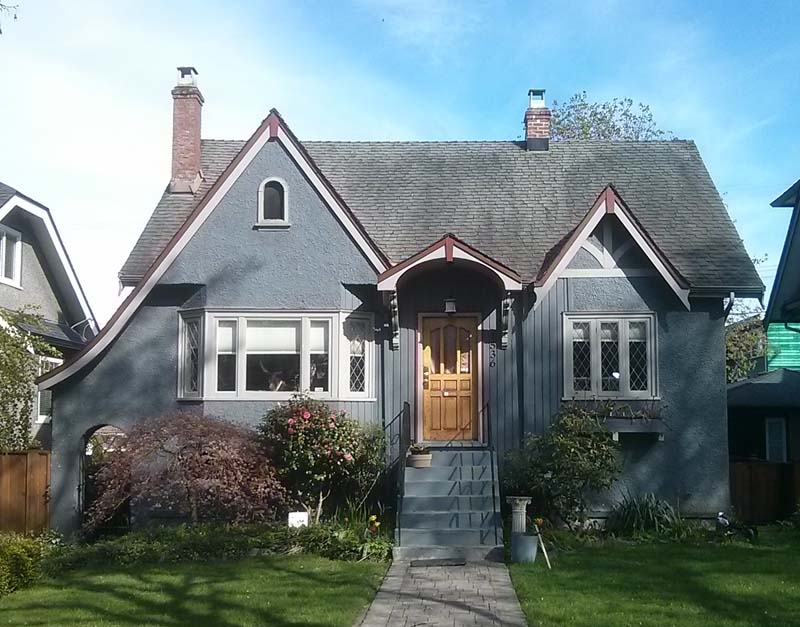
1536 Kamloops Street, with the curved "cat-slide" roof extending over a side-garden entrance.
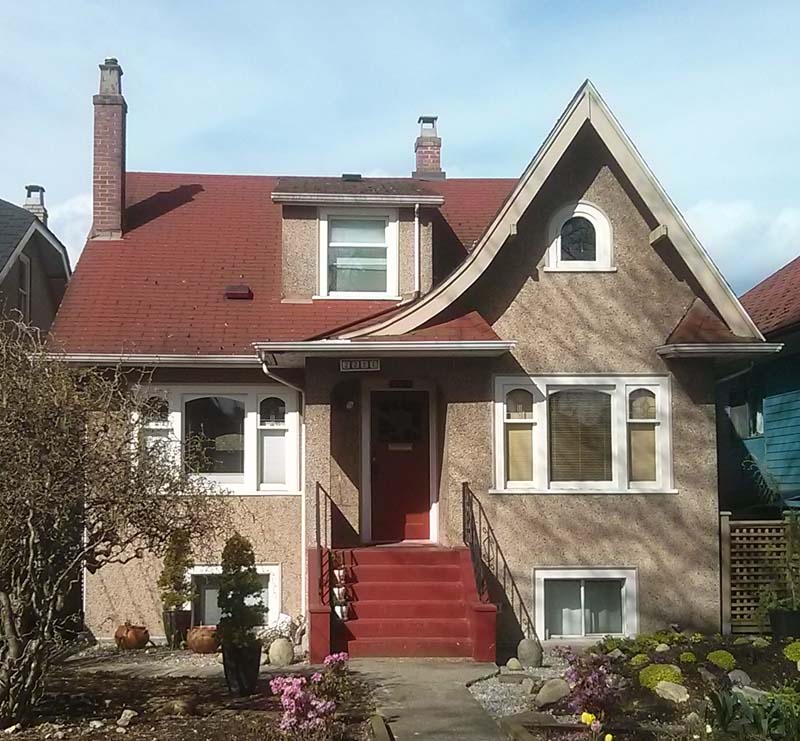
2211 Parker Street
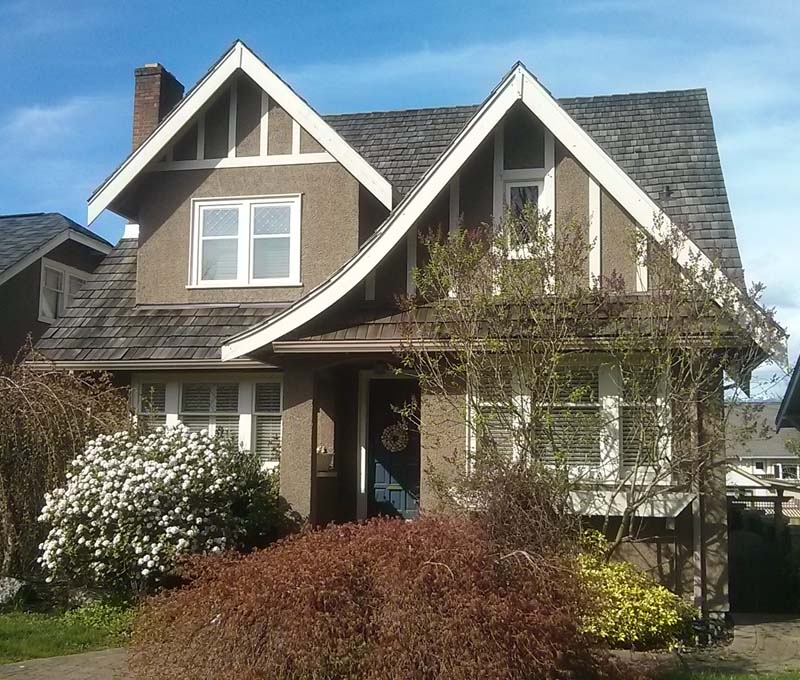
2525 Grant Avenue
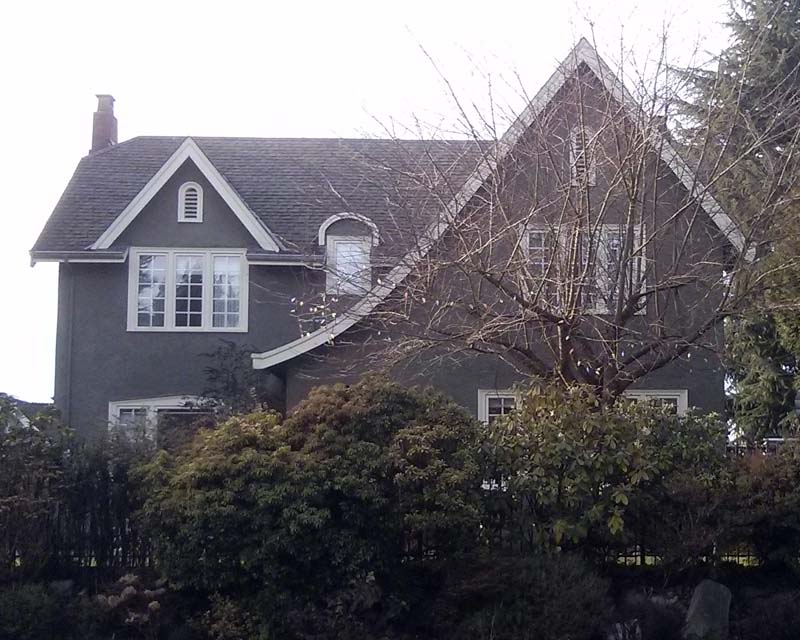
5583 Angus Drive
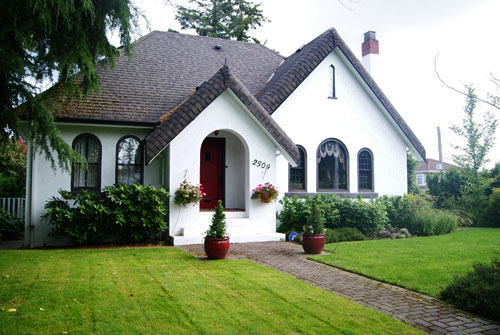 2509
West 33rd Avenue, with duroid shingles rolled over the eaves to
simulate thatching
2509
West 33rd Avenue, with duroid shingles rolled over the eaves to
simulate thatching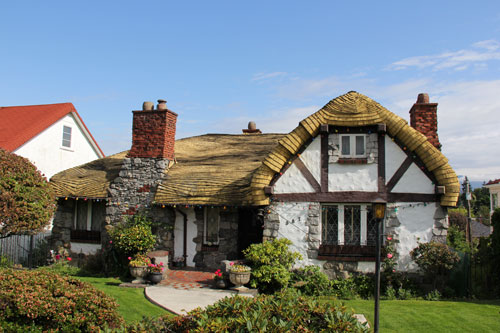 James House,
King Edward Avenue, with steamed-and-bent cedar shingles imitating
thatching, half-timbering in the gable and a rustic mixing of
claddings.
James House,
King Edward Avenue, with steamed-and-bent cedar shingles imitating
thatching, half-timbering in the gable and a rustic mixing of
claddings.French Storybook (1925 -1940).
Small whimsical houses, known as “Dunbar Castles” in that neighbourhood, with hipped or side-gabled roofs and a projecting livingroom wing (under an L-shaped roof, in some cases), with a turret tucked into the L and forming a shelter over the front door; the turret’s roof may be hipped, conical or may have crenellations (“battlements”). Windows may have arched tops, and an arched, quoined opening in the turret may frame the front door. Cladding is coloured stucco; roof edges may be rolled as in the English Storybook Style.
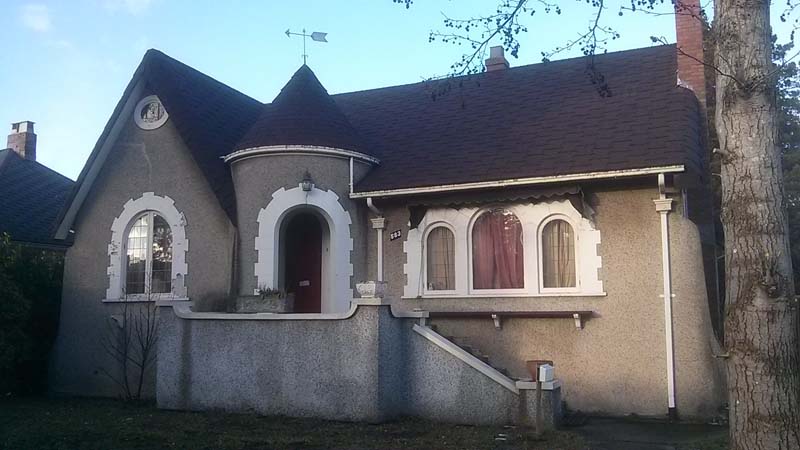
583 West King Edward, with crenellated arches around windows and doors and buttressed side walls.
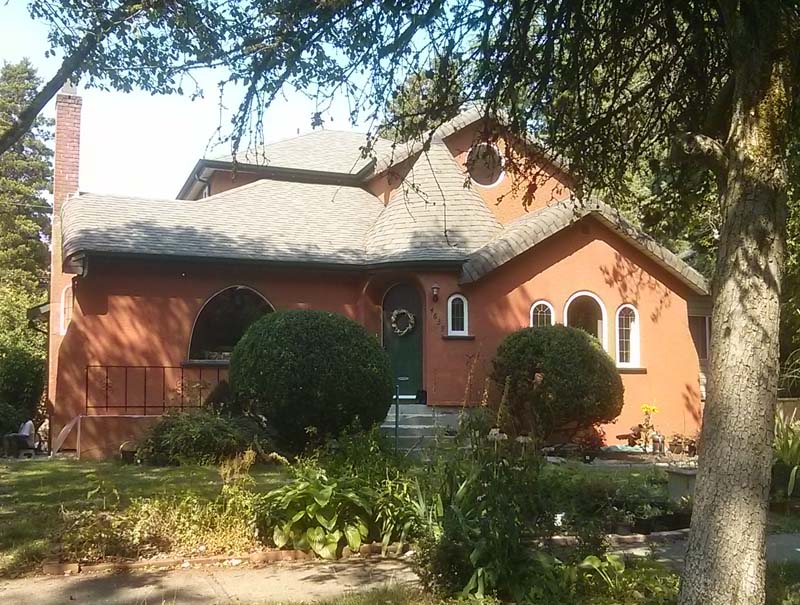
4639 West 14th, with a conical roof on the turret, rolled eaves, arched windows and buttressed side walls. The upper floor is a later addition.
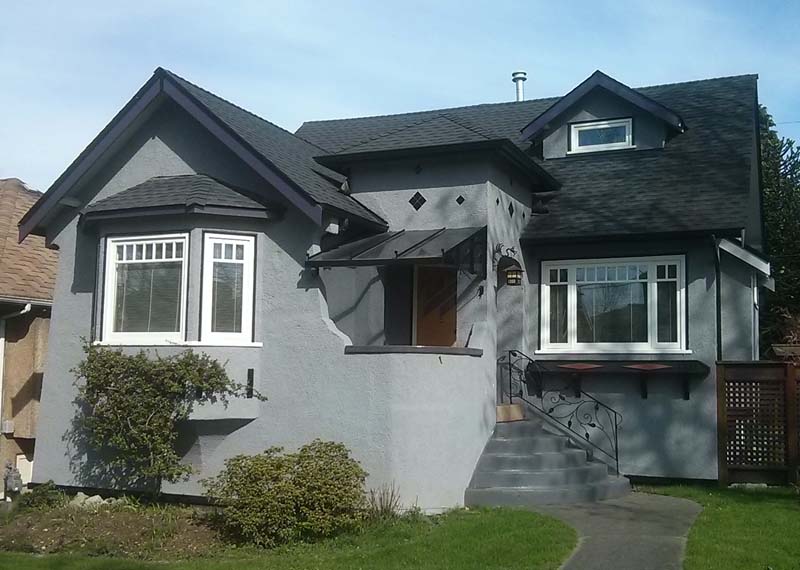
1392 Kamloops Street
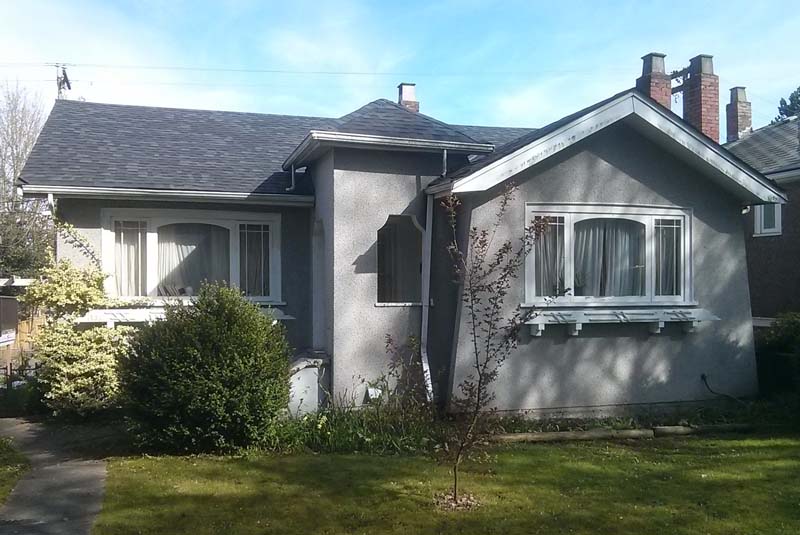
1660 Kamloops Street
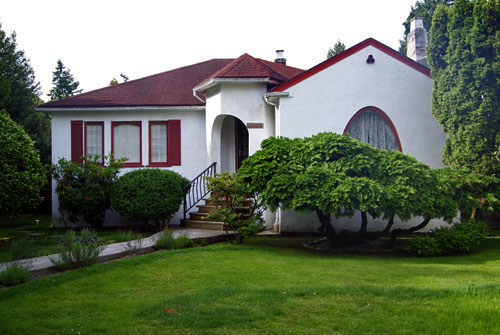 2526
West 33rd
2526
West 33rd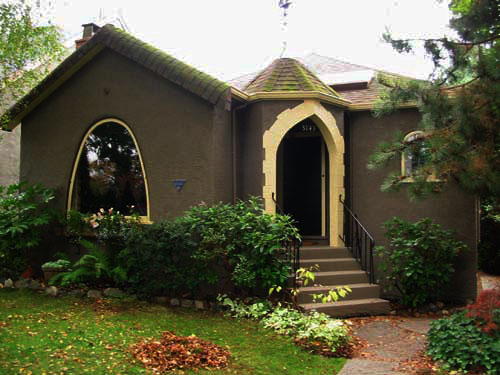 3143 Crown
Street
3143 Crown
Street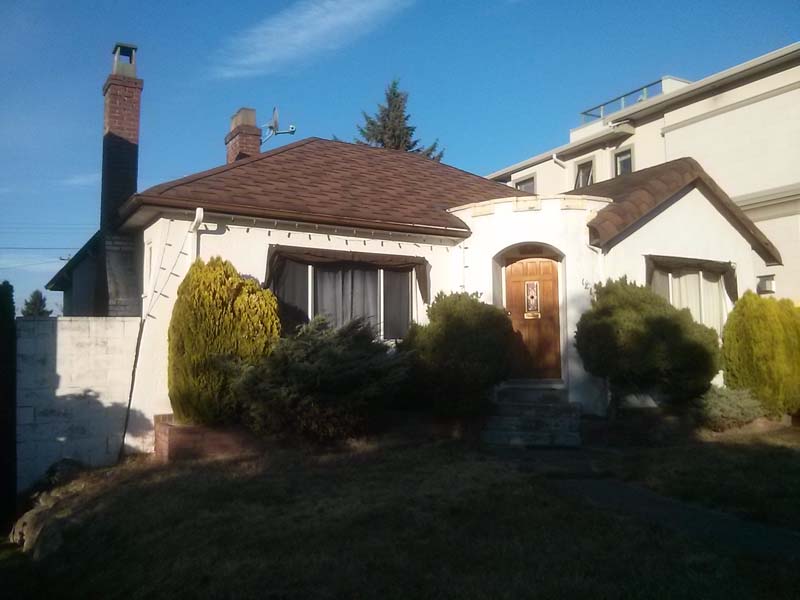
111 Peverill, with rolled eaves on the projecting bay and faux castellations on the turreted vestibule.
Dutch Colonial Revival (1910 - 1940)
Symmetrical 2-storey houses, set near ground level, with double-pitched gambrel (“barn”) roofs almost always with side gables; usually, a full-width shed-roof dormer occupies the front elevation; typically, the front door is centred, often with a fanlight above; windows are usually double-hung with shutters and often set in pairs or triples; chimneys were set on the side wall. The cladding is usually horizontal lap siding, occasionally roughcast stucco.

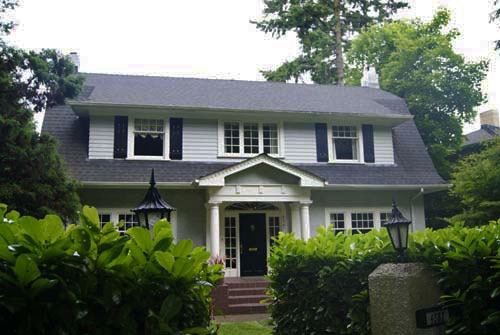 4387 Angus Drive
4387 Angus Drive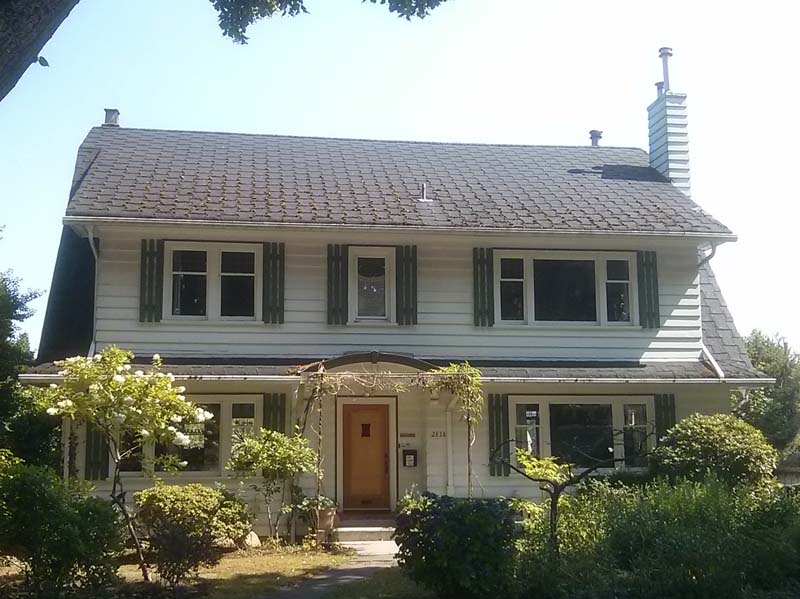
2538 Crown Street, with an arched pediment over the front door and wide lap-siding. The chimney is not original.
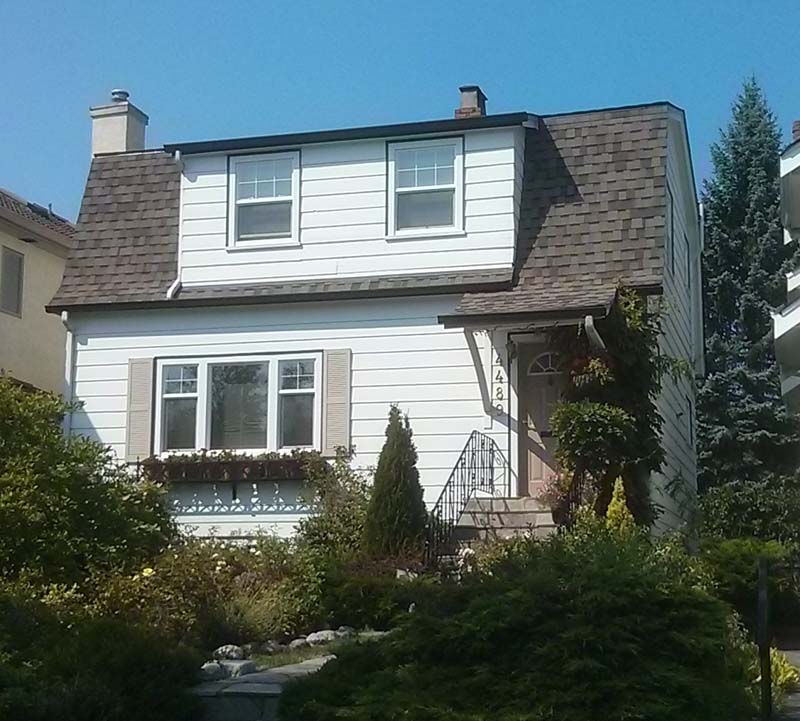
4489 West 14th, a narrow-lot version of the style.
Spanish Colonial Revival (1920 - 1940)
A style defined by low-pitched or seemingly flat tile roofs and white stucco walls, often with decorative iron grills over windows, arch-topped paired windows, small stucco parapets embellished with small tiled shed-roof projections supported by false purlins or brackets, and, occasionally, decorative towers set into the body of the roof. Front doors typically are sheltered by a portico or set forward in a projecting bay, perhaps with spiral columns or pilasters.
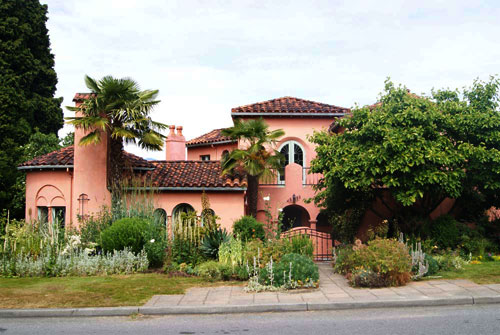 4585
Bellevue Drive, "Kania Castle" (originally painted white)
4585
Bellevue Drive, "Kania Castle" (originally painted white)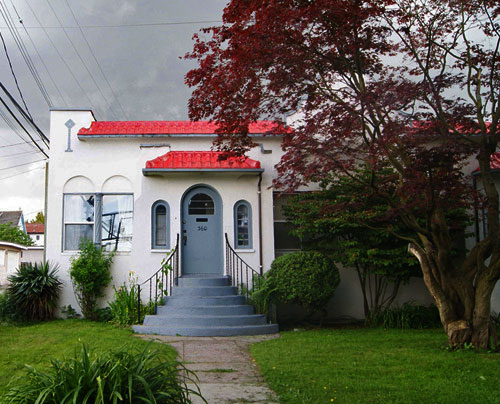 360
Penticton
360
Penticton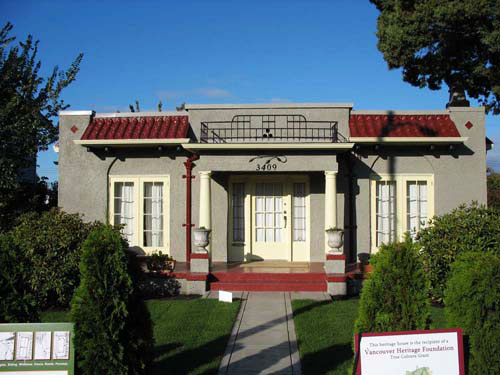 3689
Arbutus
3689
Arbutus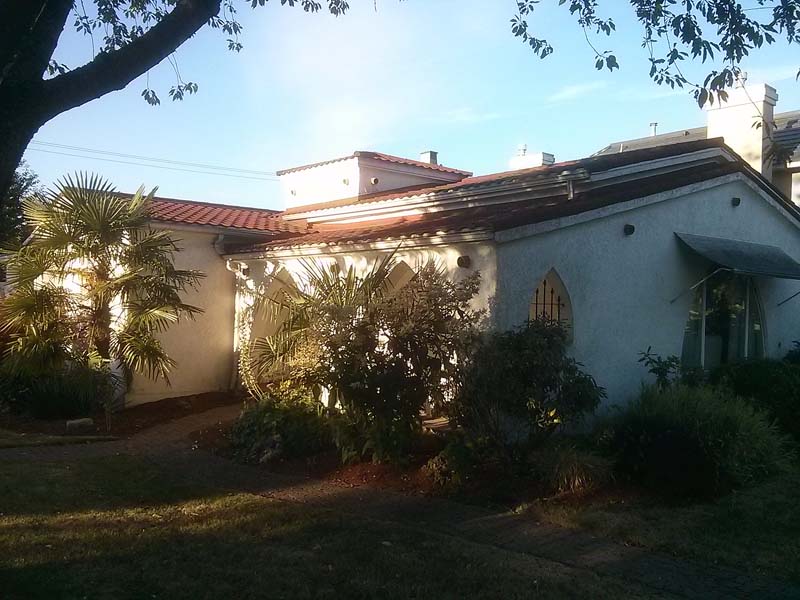
4088 Columbia, with a low-pitched tile roof of nested gables, a decorative tower and pointed windows with wrought-iron insets.
Mission Revival (1910 - 1940)
Mainly a mansion style in Vancouver, distinctive because of its curvilinear parapets at the gables; typically, the houses present a romantic, picturesque profile, with the parapets set into the side-gables and dormers. Roofs are usually tile and the cladding is roughcast stucco.
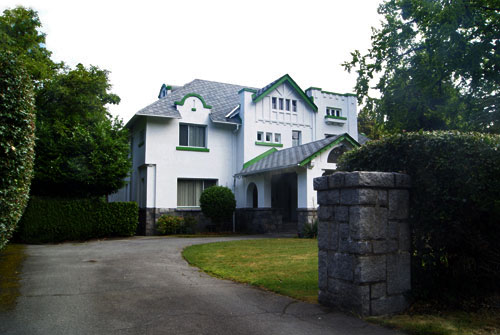 1311
The Crescent
1311
The Crescent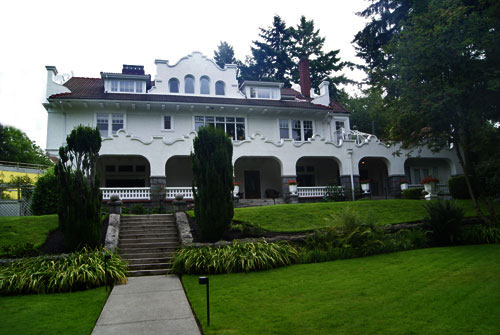 3290
Granville Street
3290
Granville Street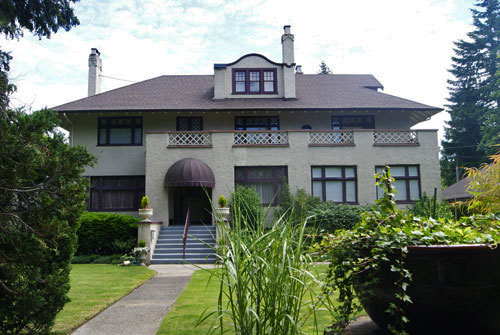 3828
Cartier Street
3828
Cartier Street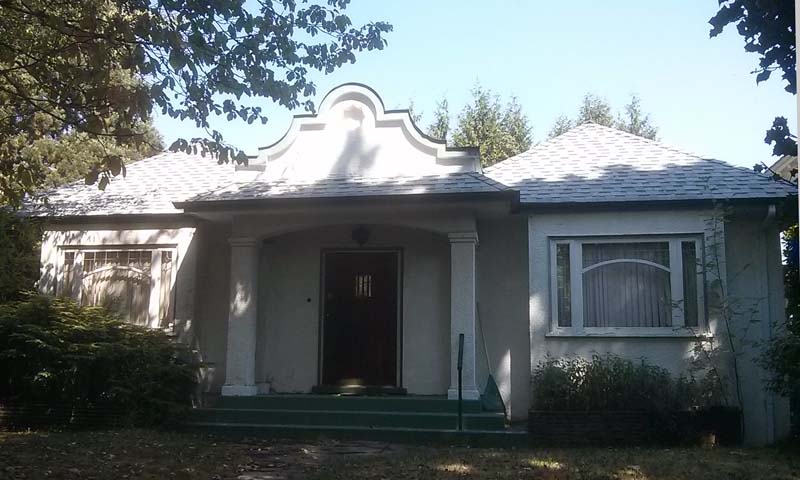
4583 West 15th, a rare single-storey example with an elaborate parapet above the front door.
Moderne (1930 - 1940)
A rare style with a flat roof, very shallow or no eaves, undecorated concrete or smooth-stucco walls sometimes curved around corners, horizontal banding and balcony railings to simulate streamlining, multi-paned fixed or casement windows that meet or wrap around at corners, octagonal or round feature windows (like portholes), substantial chimney blocks.
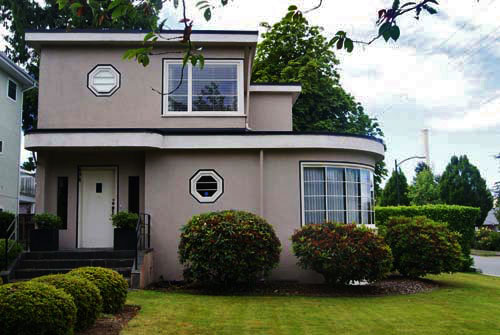 696 West 27th
696 West 27th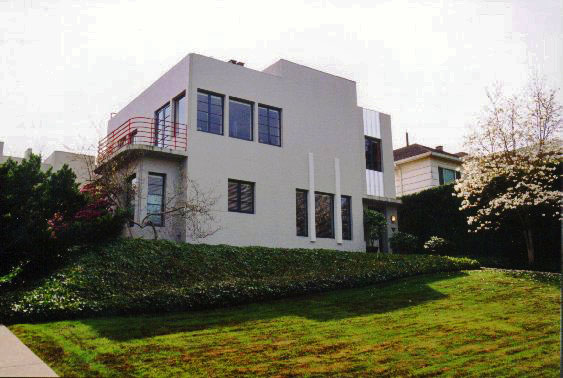 West 10th
West 10th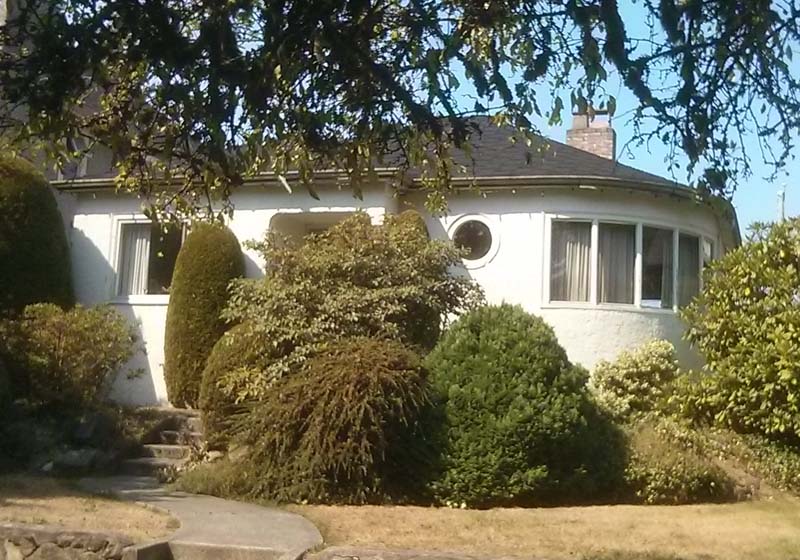
4655 West 14th, with the curved wall and porthole of the style but a common hipped roof.
Mid-Century Builder (1935 - 1965)
The vernacular house of baby-boomers’ parents. A boxy cottage with a hipped roof and no porch, with the main floor set almost a storey above grade and a basement level illuminated by fairly large windows; concrete flight of stairs ascending to a front door usually sheltered by a small hipped roof; the main floor often has a large picture window on the living room side and a smaller window on the bedroom side; cladding is usually stucco, with levels distinguished by different colours of glass-dashed (“beer bottle) or pebble-dashed stucco, although a common form has wide lap siding below the belly band and stucco above (the “strawberry box”). Octagon or diamond windows provide highlights.
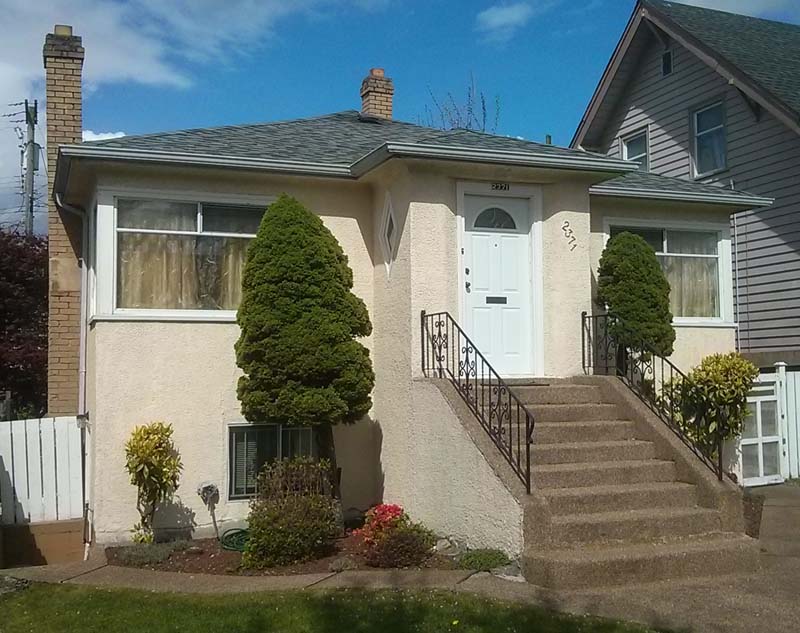
2371 East Pender Street
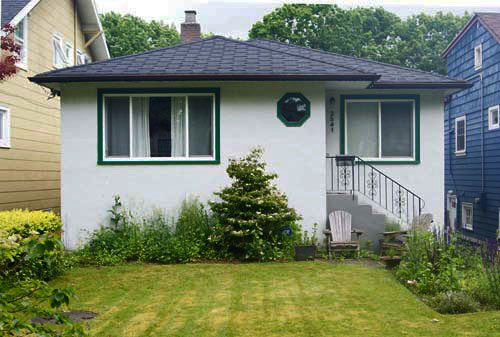 2541
Cambridge
2541
Cambridge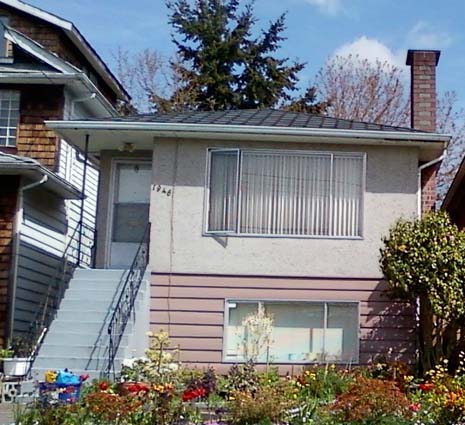 1948
Lakewood, a variant of the "Strawberry box" with the door on one
side and larger picture window
1948
Lakewood, a variant of the "Strawberry box" with the door on one
side and larger picture window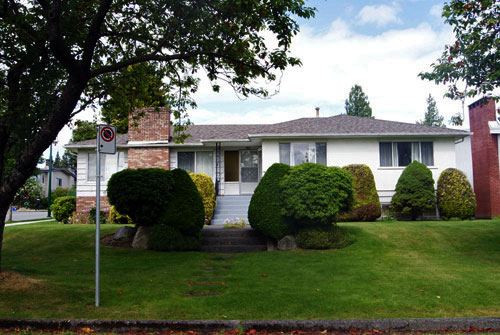 6189
Tisdall, a wide-lot variant on the west side with the prominent
chimney of the Rancher style.
6189
Tisdall, a wide-lot variant on the west side with the prominent
chimney of the Rancher style.POSTWAR
West Coast Modern (1940 - 1965)
Simple, undecorated houses set at ground level with flat or low-pitched roofs that might contain a clerestory. Deep eaves and, often, open ceilings with exposed post-and-beam structure; facades tend to be divided into panels of windows and stucco and wood, including plywood. Although some present an almost blank facade to the street, they typically have a seamless transition between interior space and garden, or wrap around a courtyard at the back.
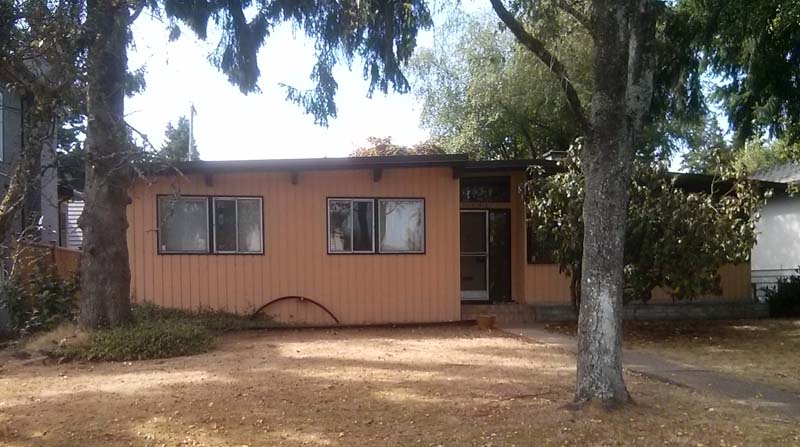
736 West 46th, with a shed roof on the projecting bay and a very low-pitched gable on the main roof; the supporting beams are visible on the front façade.
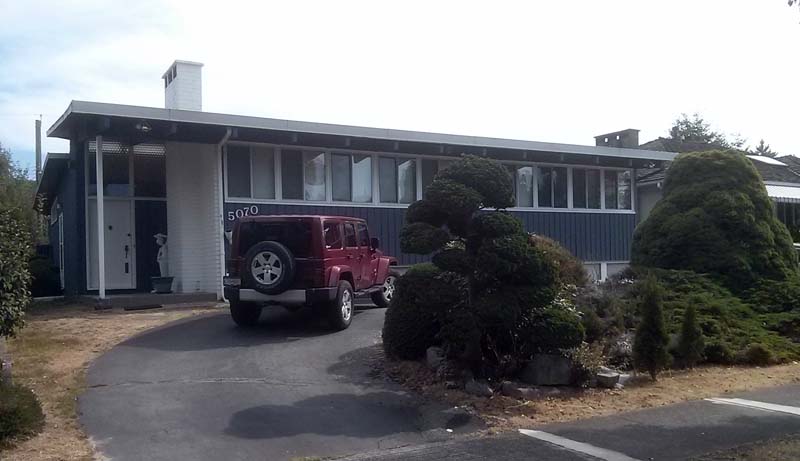
5070 Ash, with a prominent chimney block and split roofs to create a clerestory for illuminating interior corridors.
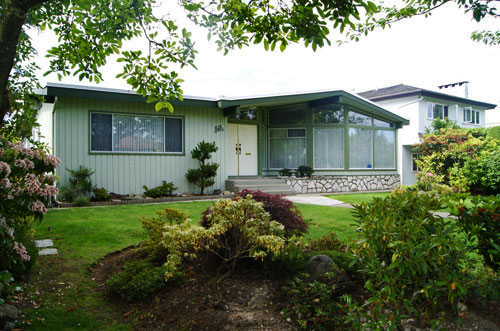 836
West 47th, with a multi-paned floor-to-ceiling picture window and
exposed beams.
836
West 47th, with a multi-paned floor-to-ceiling picture window and
exposed beams.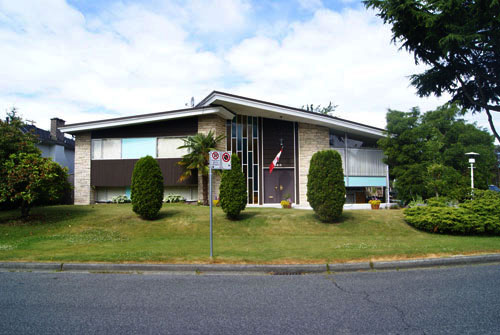 5815
Tisdall
5815
Tisdall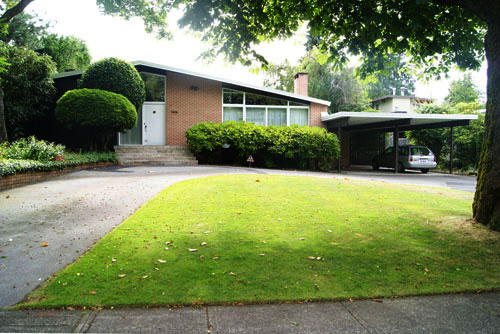 5988
Macdonald
5988
Macdonald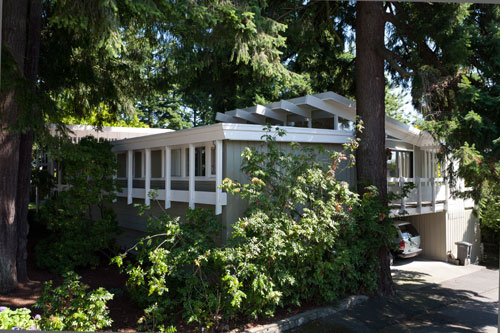 ??
??CMHC-inspired (1945 - 1965)
The “Mark” houses of the federal government’s Central Mortgage & Housing Corporation, including the Mark VII designed for Vancouver, were simple, boxy buildings with low-pitched, side-gabled roofs; the centrally located front door opened onto a half-flight of stairs for access to the main floor and the partially submerged basement. Cladding is often vertical boards. They inspired many builders with their practical floor plans and simple shapes.

815 West 46th, with side gables, an overhanging second floor, and wide lap-siding on the upper level.
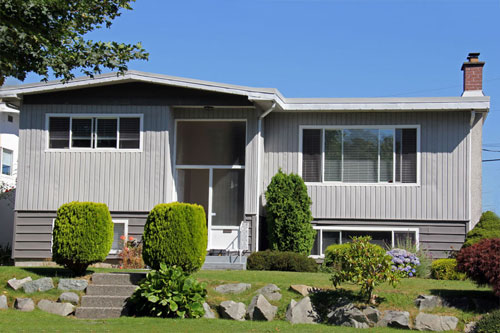 ??
??Rancher (1950 - 1975)
The popular style of the 1950s and 1960s, usually presenting a low, wide facade to the street, with a low-pitched side-gabled roof; often it will have large picture windows and a prominent chimney block providing a vertical accent – indicating its evolution from Modernist styles; in suburban areas with very wide lots it might have a garage integrated with the main roofline and facing the street. Set near ground level with subterranean basements in many cases. Many Vancouver examples are actually Split-Level style, as the lots aren't wide enough to contain the required number of rooms into a single floor.
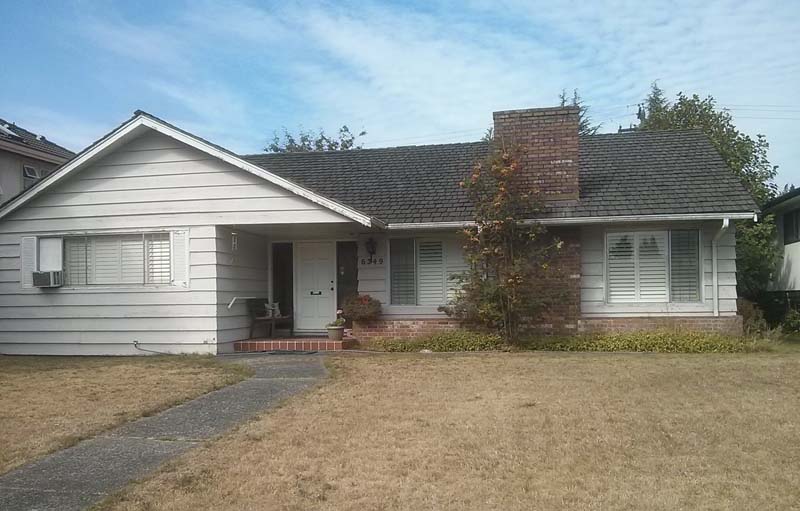
6349 Tisdall, a Rancher with side gables, a projecting gabled bay on one side, prominent chimney, and wide lap-siding.
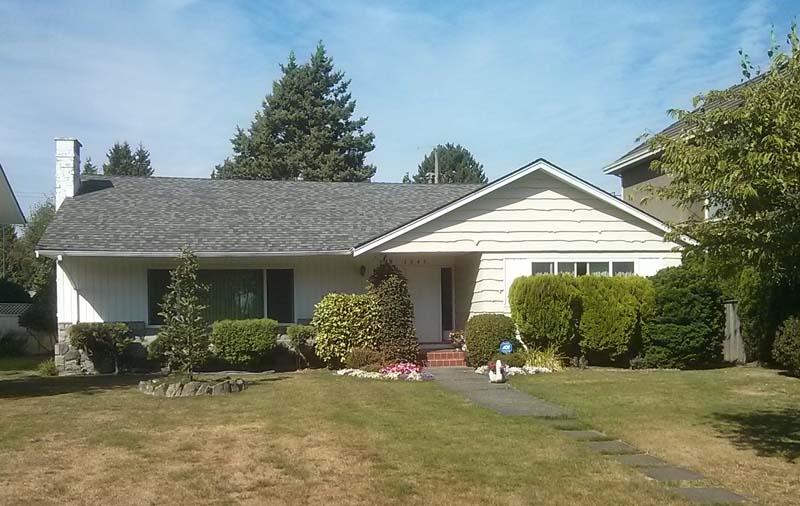
6049 Fremlin, a Rancher like the example above but with wide untrimmed lap-siding in the gable (a popular cladding in the 1950s and 1960s) and the chimney block on the side elevation.
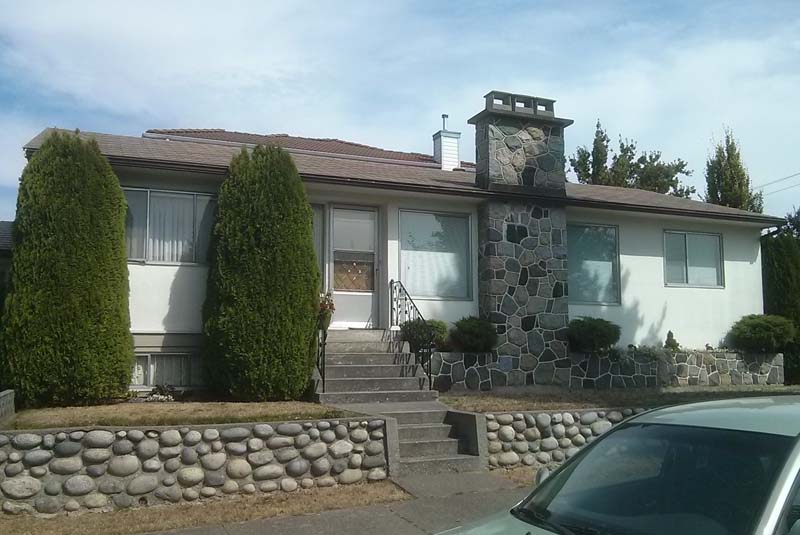
1495 East 28th, a rare east-side example of the Rancher style, made possible by turning the house sideways on a pair of narrow corner lots.
Split-Level (1950 - 1970)
Houses with side-gabled or hipped, low-pitched roofs; one side has its floor a half-storey above the other side; the front door is normally near the middle, with internal stairs leading up to bedrooms and down to a rec room on one side of the house, with kitchen and living room areas occupying the other side. They only exist on wide lots and have many of the features of the Rancher style.
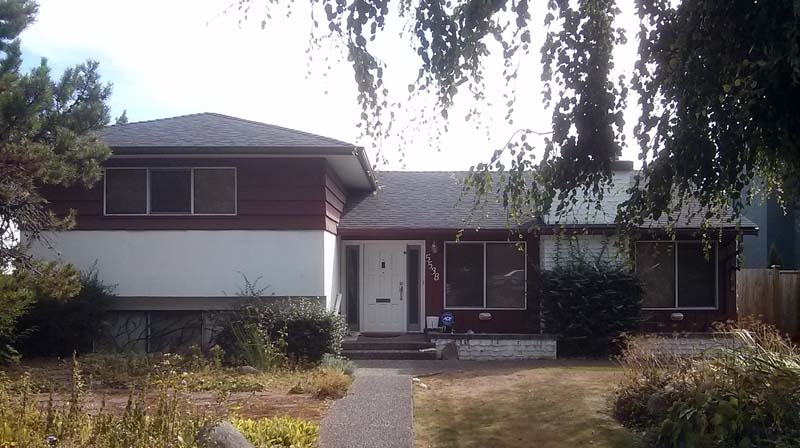
5538 Willow, with the prominent chimney block of the Rancher style.
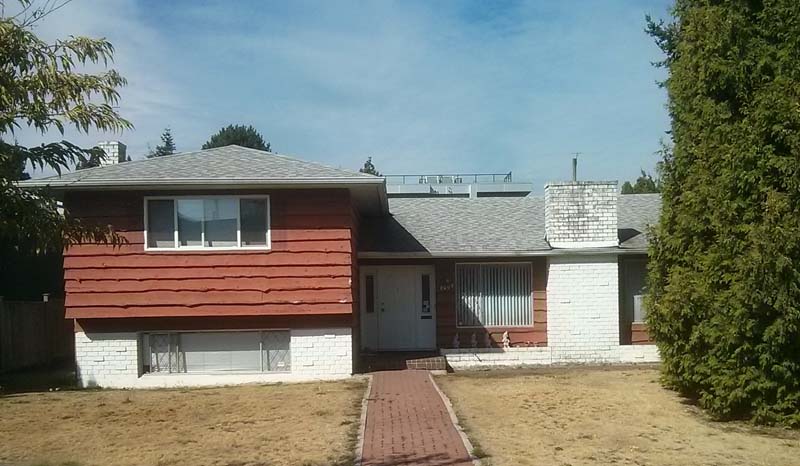
6009 Fremlin Street, with the prominent chimney block of the Rancher style and wide, untrimmed rustic lap-siding, a type of cladding popular in the 1950s and 1960s.
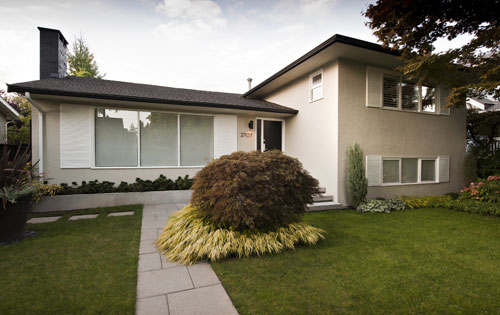 2707 West
43rd
2707 West
43rdVancouver Special (1965 - 1985)
Front-gabled, 2-storey, boxy houses built on grade with very shallow-pitched roofs which are sometimes split to create a clerestory, with a distinctive shallow balcony on the second floor accessed from sliding glass doors. On the main floor, the front door is usually set to one side, making them very easy to split into up-down duplexes. Cladding is typically decorative brick on the ground floor front façade, stucco above.
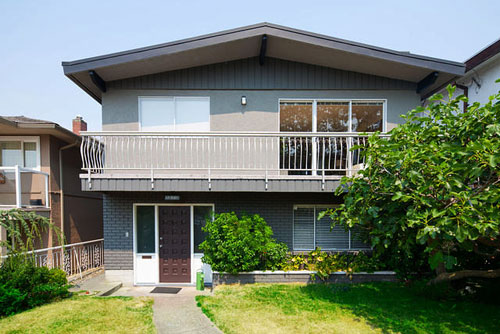
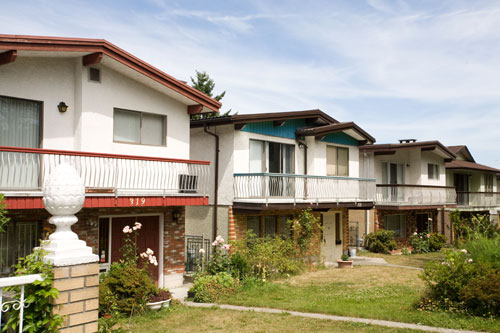
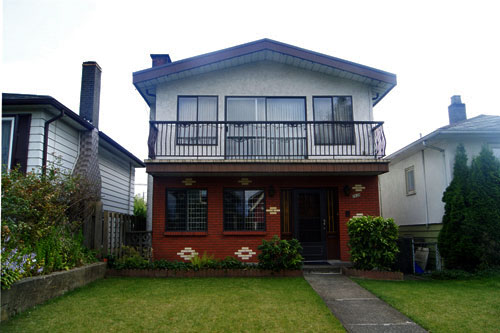 2436 Franklin
2436 Franklin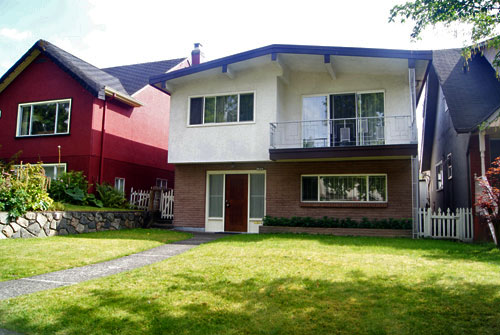 2532 Pandora Street
2532 Pandora StreetMillenium Builder (1985 - present)
Boxy, 2-storey houses with shallow-pitched hipped roofs, usually covered in tile. On some, a 2-storey bay will project from one side. Usually the main floor is set near ground level. Windows may be topped with fanlights. Cladding is stucco, although sometimes decorative brick is added to a wall or storey. On the large lots of the West Side, the complexity of indoor space requirements, such as dual kitchens, family rooms, media rooms, as well as a desire for vaulted interior spaces, sometimes creates ungainly façades reflecting the plethora of rooms inside. The big westside examples are often called "Monster Houses."
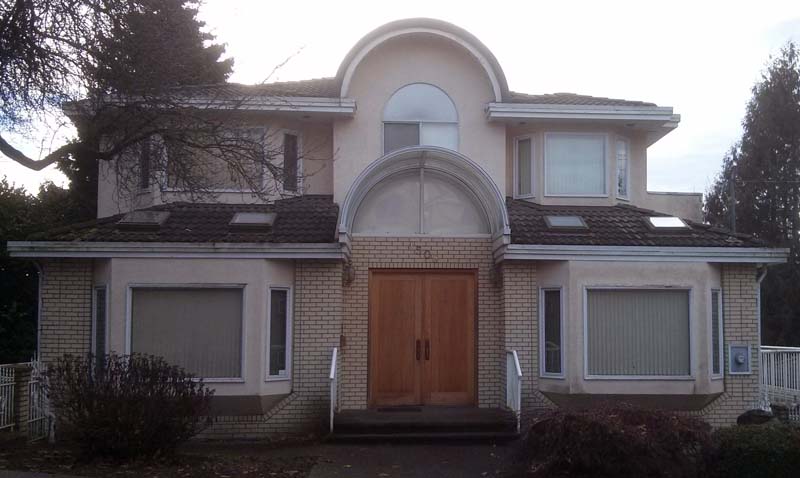
1508 West 58th Avenue, a wide-lot example on the west side with double front doors and a vaulted vestibule.
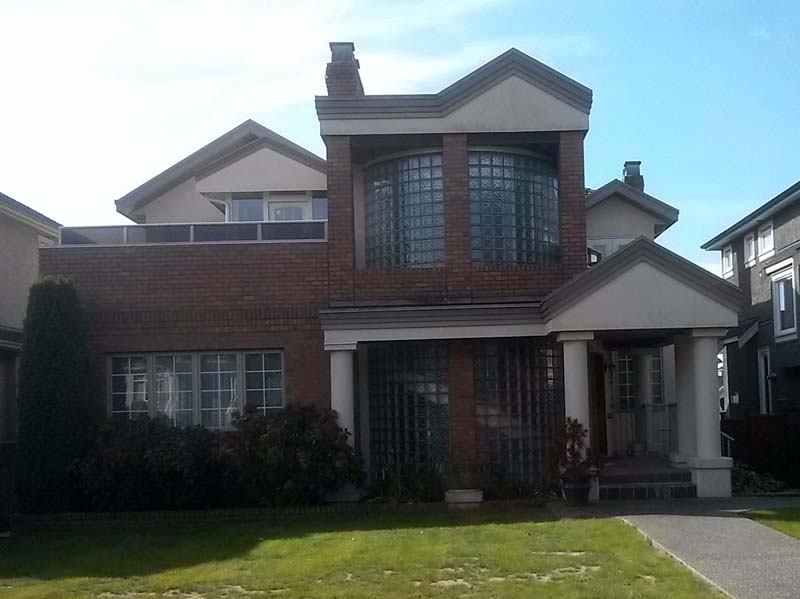
128 West 45th, a hybrid of many styles and shapes
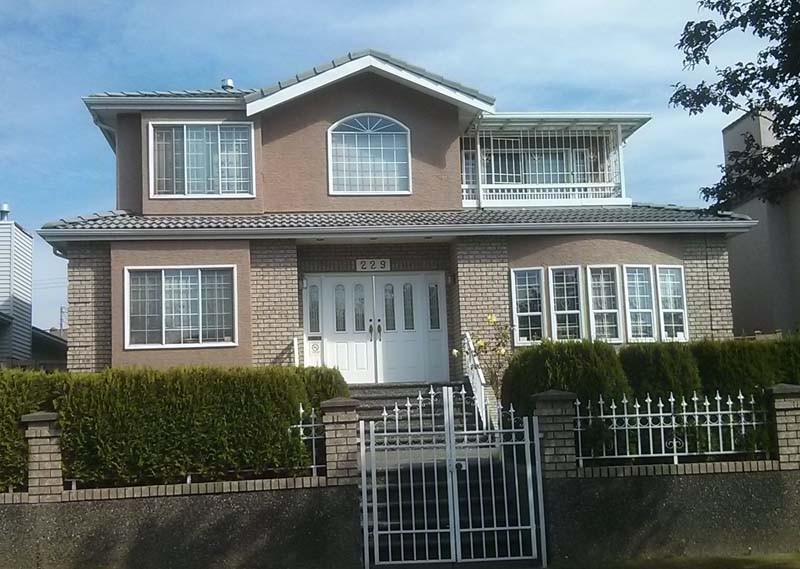
229 West 45th, with hipped tiled roofs, double front doors, mix of brick and stucco cladding, and an arched window in a projecting gabled bay providing double-height atrium space for the vestibule.
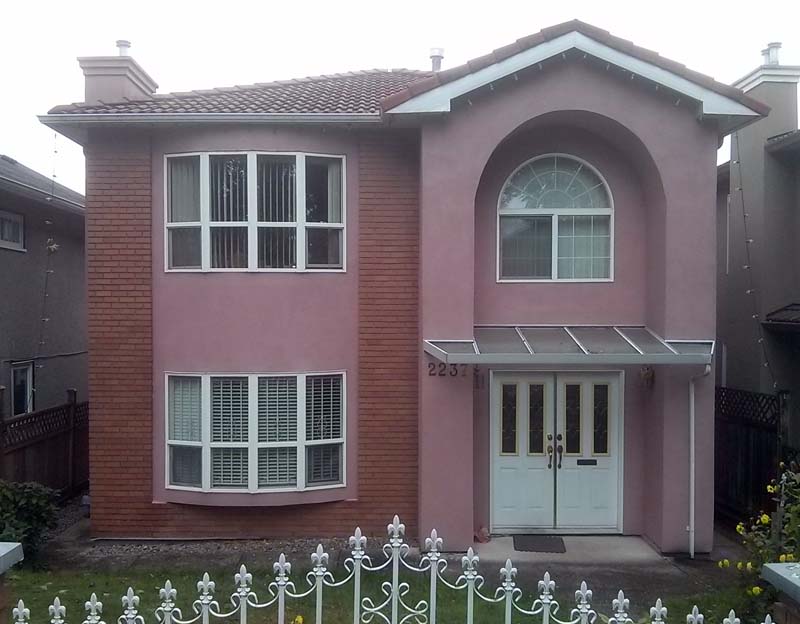
2237 Venables, a narrow-lot example on the east side with a tile hipped roof, a shallow projecting gabled bay on one side of its asymmetrical façade, a two-storey bay window on the other, double front door and arched window in the atrium space above.
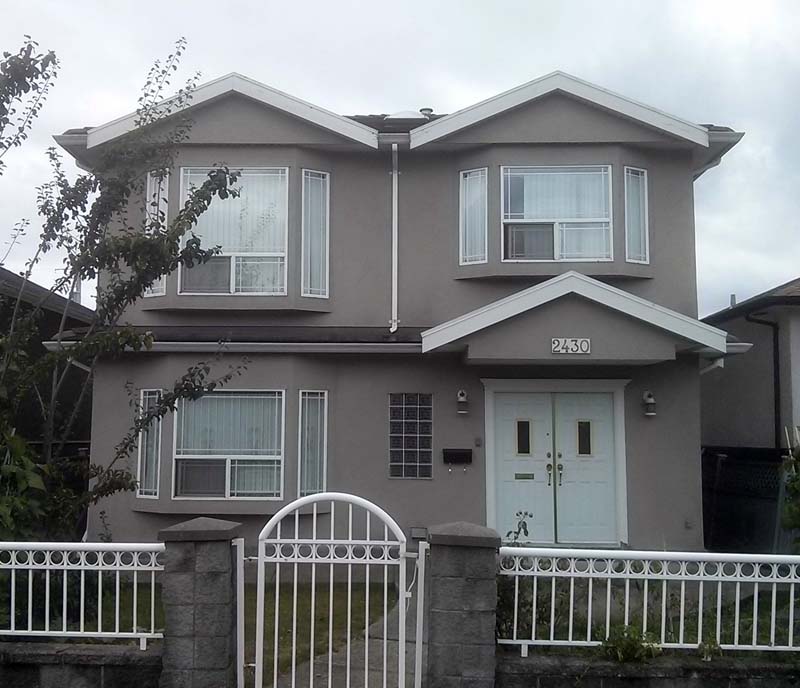
2430 Adanac, an example on a 33-foot lot with a common roof design: two shallow-pitched gabled roof dormers protruding from the hipped roof.
Millennium Contemporary (1995 – present)
Typically a flat-roofed style assembled with cubic forms; windows, which often have strongly horizontal dividers, are placed asymetrically within the walls; materials may include exposed concrete, standing-seam sheet metal and wood.
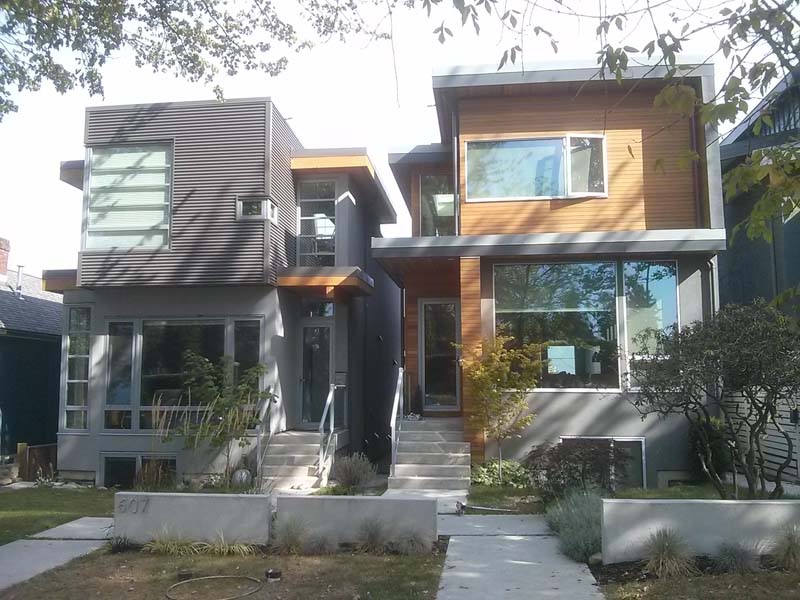
607 and 611 East 31st, with complex cubic forms and flat roofs.